Literary Theory and Criticism
Home › British Literature › Analysis of Katherine Mansfield’s The Doll’s House

Analysis of Katherine Mansfield’s The Doll’s House
By NASRULLAH MAMBROL on July 10, 2022
Published in The Dove’s Nest , Katherine Mansfield’s last collection of short stories, “The Doll’s House” belongs with “Prelude” (1920) and “At the Bay” (1922) among the Burnell stories, a trilogy based on the re-creation of a New Zealand childhood that threads family life with social satire while exploring issues of identity and belonging. The story, divided into three sections, uses the central metaphor of the doll’s house, which also provides the linear and dramatic framework of the narrative. It begins with the arrival of a completely furnished doll’s house sent to the Burnell children by “dear old Mrs. Hay,” a friend of the family. When Pat, a servant, opens the house, Isabel, Kezia, and Lottie cannot believe their eyes: “It was too marvellous; it was too much for them.” But while her sisters admire this imitation of gaudy bourgeois comfort, Kezia, Mansfield’s recurring figure of the open-minded girl, is drawn by the perfection of an “exquisite little amber lamp” that looks “real” to her.

In the second and third sections of the story, the doll’s house becomes a source of social and psychological conflict as it is turned into an instrument of power by Isabel, the eldest Burnell sister, and the other schoolchildren invited to share her euphoric pride. Cruelly excluding the Kelvey girls from their companionship and from the pleasure of seeing the doll’s house because they are the daughters “of a washerwoman and a gaolbird,” Isabel and her friends reproduce their parents’ prejudiced views and social sense of self-gratification without questioning them. The narrative works up to an epiphanic climax when Kezia, “the potentially free subject,” to use Kate Fullbrook’s terms (113), breaks with social and family conventions by opening “the big white gates” of her home and her heart to allow Lil and Else Kelvey a hurried glimpse at the doll’s house. Over a short moment of symbolical intensity, the three children are drawn together in a shared experience of vision and beauty: “[Else] put out a finger and stroked her sister’s quill; she smiled her rare smile. ‘I seen the little lamp,’ she said.”
As are most of Katherine Mansfield’s stories, “The Doll’s House” is poised dialectically between the external world of social reality and an internalized world of subjective perceptions. Its Modernism lies in its refusal to rely on narratorial intrusions (the text is full of ironic insights but is never judgmental) and in its use of point of view and indirect free form to convey inner feelings, of symbol and metaphor as structural elements, and of epiphany as the ephemeral moment when the focal character and the reader might gain access to truths hidden to ordinary perceptions: Not only do Kezia and the Kelvey sisters know that the doll’s house is a social symbol of status and discrimination, they also see in its little lamp the metaphorical values of shared knowledge and emotion, while the whole story suggests that artistic creation may be a redeeming act of inclusion and fulfillment.
“The Doll’s House” is also typically Mansfieldian in the way the narration oscillates between ironic distance and emotional empathy, using “impersonation” as a form of speech representation that captures the subtle nuances of a character’s tone of voice and makes for immediacy but also ambiguity and ironic contrasts. However, the epiphanic accomplishment characterizing this story makes it different from most of the other short fiction by Mansfield: Far from being an experience of self-deception or self-betrayal, the expected revelation is here a “blazing” if evanescent moment of discovery and happiness.
BIBLIOGRAPHY Fullbrook, Kate. Katherine Mansfi eld. Bloomington: Indiana University Press, 1986. Kobler, J. F. Katherine Mansfi eld: A Study of the Short Fiction. Boston: Twayne, 1990. Mansfi eld, Katherine. The Dove’s Nest and Other Stories. London: Constable, 1923
Share this:
Categories: British Literature , Literature , Short Story
Tags: Analysis of Katherine Mansfield’s The Doll’s House , appreciation of Katherine Mansfield’s The Doll’s House , essays of Katherine Mansfield’s The Doll’s House , guide of Katherine Mansfield’s The Doll’s House , Katherine Mansfield’s The Doll’s House , Katherine Mansfield’s The Doll’s House essays , Katherine Mansfield’s The Doll’s House guide , Katherine Mansfield’s The Doll’s House Katherine Mansfield’s The Doll’s House criticism , Katherine Mansfield’s The Doll’s House notes , Katherine Mansfield’s The Doll’s House plot , Katherine Mansfield’s The Doll’s House summary , Katherine Mansfield’s The Doll’s House themes , notes of Katherine Mansfield’s The Doll’s House , plot of Katherine Mansfield’s The Doll’s House , structure of Katherine Mansfield’s The Doll’s House , Summary of Katherine Mansfield’s The Doll’s House , Themes of Katherine Mansfield’s The Doll’s House
Related Articles

You must be logged in to post a comment.

The Doll’s House by Katherine Mansfield | Summary and Analysis
Analysis of the doll's house by katherine mansfield.

The Doll’s House by Katherine Mansfield, published in 1922, is a short story written in third-person, through an omniscient narrator. It discusses societal class and ostracization through the lens of two sets of school-going sisters from different family backgrounds.
The Doll’s House | Summary
The story starts with Mrs. Hay- a previous guest at the Burnell’s residence- sending a lovely, large dollhouse as a gift to the family’s three daughters- Isabel, Lottie, and Kezia. It smelled of paint, but the decorations and detail were perfect, and the girls were thrilled. The youngest sister, Kezia, especially loved the little amber lamp with its white globe, standing in the middle of the dining table. She thought the dolls looked too large and unnatural for the dollhouse- meanwhile, it was the tiny lamp that seemed to fit perfectly, as though it was meant to live there.
The Burnell sisters were already popular at school, being from a family that was relatively well-off for their location. In fact, their mother disapproved of the school, for the girls had to mix with the children of grocers and milkmen. However, she allowed the sisters to bring their friends home two by two to see the dollhouse. When Isabel explained the dollhouse to their friends, Kezia felt she was not giving nearly enough importance to the little lamp- but it did not matter, as Isabel was the one choosing the first two visitors. The only girls who did not participate in this excitement were Lil and Else Kelvey- they sat outside the circle and listened in without saying a word. Those two sisters were social outcasts- their mother was a washerwoman and their father was allegedly in prison. Else never said a word, quietly following Lil’s lead. Many parents, including the Burnell sisters, forbid their children from mingling with them.
As days passed, the Burnell’s dollhouse became the talk of the school. Everyone had visited and admired it and discussed it eagerly in class the next day. As usual, the Kelveys sat on the outside looking in. Kezia asked her mother one day if she may invite the Kelveys, but she was firmly turned down, with her mother saying, “You know why not.” In the end, the Kelveys were the only ones who hadn’t been invited to see the dollhouse, and it turned the school’s attention onto them. One day, the schoolgirls were being especially rude to the two sisters, a girl named Lena even asking Lil if she would be a servant when she grew up. Lil did not pay heed, which infuriated Lena into making a comment about the Kelveys’ apparent criminal father. The other girls shrieked with shock and excitement and went to play jump rope with a renewed vigor.
A few days later, when the Burnell girls were getting ready for a visitor, Kezia saw the Kelvey sisters walking near her house’s gate. She quietly opened it and beckoned them in, asking if they wanted to see the dollhouse. They refused, as their mothers said the Burnell’s weren’t allowed to speak to them. But at Kezia’s firm insistence, they stepped foot into the courtyard. Lil and Else were able to get a view of the dollhouse, and even briefly saw its interior before Kezia’s Aunt Beryl appeared and furiously shooed them away. Aunt Beryl was already in a bad mood because she received a letter from William Brent demanding he meet her at midnight, otherwise he would turn up at her door. The pressure of the letter vanished after she frightened the Kelveys and scolded Kezia.
Meanwhile, the two Kelvey sisters were out of sight from the Burnell’s house. They sat on a drainpipe and gazed into the distance in silence, almost dreamily. They had already forgotten the scolding of Aunt Beryl- their mind was fixed on the dollhouse they finally managed to see. It was Else who spoke, for the first time in the story, saying that she had seen the little lamp. The two continued to sit in silence.
The Doll’s House | Analysis
Katherine Mansfield , born and raised in New Zealand, was one of the most famous writers of her time. She often wrote in third-person and portrayed elements of her personal experiences. The theme of her work usually matched the situation she was undergoing in her own life. The Doll’s House is written in third-person using an omniscient narrator, and it translates the nuances of very deep elements in an insightful yet simple way . The main themes are class prejudice, social hierarchy and ostracization, and innocence. Because the main characters are young schoolgirls, these topics are put forth in a rather straightforward manner- after all, young children have far less direct awareness or conscience, and their way of thinking is often precise. However, we also see the cruelty of this forthrightness in the way the children do not hesitate to bully and mock their classmates of a lower social sphere. This shows the normalization of treatment based on hierarchy , as well as the influence of society on children’s mindsets . Similes, metaphors and imagery are employed throughout this piece.
Mansfield also uses object symbolism to portray key aspects of the story. Starting from the very beginning, when the Burnell girls are gifted a dollhouse , Mansfield establishes the concept of social class . The dollhouse is a direct representation of the Burnell’s own house – it is large, the girls are thrilled by it, and it seems furnished to the detail. However, its description is not entirely flattering- “a dark, oily, spinach green, picked out with bright yellow” and “ the smell of paint coming from that doll’s house was quite enough to make anyone seriously ill.” Further, it is important to note “ When dear old Mrs. Hay went back to town after staying with the Burnells, she sent the children a doll’s house. ” This implies that the Burnells themselves do not live in the central part of town , but in the outskirts. Hence, the dollhouse symbolizes that though the Burnells may not be extremely rich on a large scale, they are well-to-do and of a higher social class within their area of residence.
The fact that when the sisters went to school and Isabel talked about the dollhouse is also a portrayal of the automatic respect and flattery given to those with more money or at a higher rank :
“The girls of her class nearly fought to put their arms round her, to walk away with her, to beam flatteringly, to be her special friend.”
This emphasizes the superficiality of these advances- none of the girls wanted to spend time with Isabel because they liked her as a person. They did not want to be her ‘ special friend’ because they enjoyed her company. It was simply out of the eagerness to see the magnificent dollhouse. At this time, the Kelvey sisters being left out represents the lower rung of the social hierarchy. The fact that it is the other children’s parents who forbid them from mingling with Else and Lil showcases how society and adults can impact a child’s behavior . For example, “ For the fact was, the school the Burnell children went to was not at all the kind of place their parents would have chosen if there had been any choice.” – this automatically instills in the Burnell children a superiority complex.
Else never spoke and stuck close to her sister Lil- “Where Lil went, our Else followed.”- which shows the demure nature. It also emphasizes a level of acceptance from both of them- they never tried to fight back or defend themselves as they knew nothing would come of it, but simply ignored the mocking and jeers and moved on. They seem to have realized that things will not change, and they are stuck in the social class they were born into. The fact that these girls have understood this and cope with it at such a young age makes the reader realize how normalized it is, which is quite unfortunate. The description of Lil and Else sitting outside the circle of schoolgirls and constantly having to listen in is a direct depiction of being socially ostracized – closed off, on the outside looking in.
Kezia, the youngest Burnell sister, is the only one of the family- of the whole school, maybe- who questions the social ostracization of the Kelveys . She wants to invite the sisters home to show them the dollhouse, as well- her youth and innocence put everyone on a level playing field . While the rest of her family sees things from the perspective of social status and financial importance, she simply sees everyone as people . She views the world in a more wholesome manner. When she sees the Kelvey sisters near her house, she is swinging on the white gate of her house. This white gate is what separates the Burnells from the outside world, trapping them in their bubble of greater wealth and societal class . As a material divide between the Burnells and the rest of the area, the gate represents t he separation of the social spheres . Kezia swings on it back and forth, teetering on the edge of this imposed border, which symbolizes her different outlook . Unlike her family, she does not understand why the Kelveys are kept at a distance.
When the family receive the dollhouse, Kezia alone fixates on the tiny lamp –
“The father and mother dolls, who sprawled very stiff as though they had fainted in the drawing-room, and their two little children asleep upstairs, were really too big for the doll’s house. They didn’t look as though they belonged. But the lamp was perfect. It seemed to smile at Kezia, to say, “I live here.” The lamp was real.”
This lamp is symbolic of innocence and hope . It does not stand out extraordinarily, which is why none of the older sisters or adults find it interesting. Yet its gentle, modest appearance is what draws Kezia to it- this highlights a younger child’s perspective. The lamp is a form of hope for Kezia and the Kelvey sisters- for after being chased away by Aunt Beryl, Else smiles for the first time and says, “I seen the little lamp.” It is an unspoken bond between Else and Kezia- that they are able to see beyond the discrimination of the adults in the society. They notice and appreciate the same things- a small detail like a lamp, rather than the grandeur of the rest of the dollhouse. Their youth stops them from fully comprehending the reason for this class divide, but their innocent and open-minded attitude forms a ray of hope that even when they are older, they will be able to see everyone as human rather than by social status.
Lines Written In Early Spring | Summary And Analysis
Pink bow tie | summary and analysis, related articles.
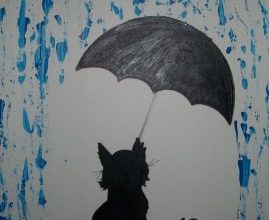
Cat in the Rain Summary

The Seventh Man Summary
Follower | summary and analysis, the law of life summary, leave a reply cancel reply.
Your email address will not be published. Required fields are marked *

Adblock Detected
Jotted Lines
A Collection Of Essays
The Doll’s House by Katherine Mansfield – Analysis
Mansfield’s story ‘‘The Doll’s House’’ is a work that relies on the careful balance of its elements in order to make its unstated points felt. Elements are juxtaposed against each other to highlight their similarities and differences. Mansfield does this tactfully and subtly, so that even a careful reader might not see it until the story’s end. It is at the end, in the second-to-last line, that Else Kelvey, known throughout as ‘‘our Else,’’ speaks, and it is then that things fall into place. In an instant, it becomes clear that Else is a kindred spirit with Kezia Burnell, which leads to other observations about similar relationships throughout the story.
The Burnells are really a mirror image of the Kelveys, a point that is not immediately apparent because there are three girls in one family and two in the other. It becomes clearer when one considers the middle Burnell, Lottie. She has no presence in the story; she never even speaks, but only serves to amplify Isabel’s positions. Ignoring Lottie, at least for a while, leaves two Burnell sisters and two Kelvey sisters. There are also two sisters of the previous Burnell generation who have speaking roles in the story. In addition, there are girls who come two-by-two to the Burnell house. The only male presence is Pat the handyman, though in the story he does not really exert any personality; as a laborer, he functions for the Burnell household as a shovel or his handy pocket knife would function for Pat himself. He is a device for the family to use, not something to be dealt with. Mr. Kelvey, according to Gillian Boddy, appeared in an earlier draft of the story, driving a fish wagon but always so drunk that he is in constant danger of falling off. In the published version he is simply absent, like the father of the Burnell household.
Reading the story in terms of its dichotomies makes it easier to see how it works. The plot can be boiled down to a basic contrast between the two oldest daughters, Isabel Burnell and Lil Kelvey, as they reach the point in their lives when their social fortunes take them in opposite directions. The crux of the story, its heart, is a different matter, but its focus is on the schoolgirls making sense of the prevailing social order. The first few pages show how Isabel stumbles across the secret of social success as she goes from bragging about the lively new doll’s house to pitting her schoolmates against each other for her affection. This all culminates in the yard at lunch one day when the other girls notice that Isabel might be amused by mocking Lil’s poverty. Told that Lil will grow up to be a servant, Isabel’s words properly express shock, but her eyes convey just the slightest hint of another meaning. Another girl picks up on the clue and goes to taunt the pathetic Lil, first with a snide question and then with outright hostility. The girls find delight in Lil’s humiliation. Mansfield’s wording about this leaves no doubt that a corner has been turned: they were, she says, ‘‘deeply, deeply excited, wild with joy.’’ It is such a transformative moment that she leaves it up to readers’ imaginations as she explains that the girls are driven to doing unspecified ‘‘daring things.’’ Sexuality is not necessarily involved, but the feel of transgression and the pretense of maturity associated with it are certainly there. The girls find themselves moved up to a new social level by taunting Lil, and at the top of them all is their leader, Isabel.
And that is not even the final humiliation of Lil. This comes at the end of the story when, having been shown some degree of awkward kindness by Kezia, she is put down again. This time, it is not a gaggle of girls who are learning that cruelty can benefit them socially, but an adult, who berates Lil simply for existing. Though she does not know it, Lil could be as refined as the enchanting doll’s house that started the social disruption and Aunt Beryl would still find herself objecting to the girl’s smell. If Lil has been silenced when she attempted to edge into the group and listen to Isabel’s description of the house and humiliated by Lena’s direct assault about her father, she ends up ultimately mortified by Aunt Beryl shooing her away like a rat. Her mortification is so complete that her little sister Else tries to comfort her, petting the feather on her beaten old hat and pointing out that some good came from this miserable adventure after all, as she has at least seen the little lamp. In this, Else offers hope.
The story can be viewed as the divergence of Isabel and Lil, who do not start as social peers but rise and sink, respectively, so that they end up far, far apart. The story’s heart, however, is clearly found in the way that their younger sisters, Kezia and Else, form an unspoken, possibly even unrecognized, bond.
Kezia is the outcast of her family. Unlike Else, she has no comfort to offer her sisters, who do not need comforting anyway. While Else stands behind Lil, holding on to the hem of her dress so that they won’t be separated, Kezia tries to wheedle her way into Isabel’s discourse to the schoolgirls about the new doll’s house, finding her effort futile. In the story’s final scene, Kezia walks off by herself as her family is inside, preparing to receive visitors. She does not feel any need to be with them, and they, apparently, find no need to go out looking for her, until Aunt Beryl, taking out her own frustrations, comes out and scolds her. There is no indication that Kezia and Else have anything in common until Else tells her sister about seeing the lamp, speaking with the same delight that warmed Kezia. Mansfield gives no indication whether interest in the lamp is passed from one to the other or just grows spontaneously in both youngest sisters; if both just happen to find the lamp enchanting, it says something about young people and their ability to be enchanted, while if Else is just repeating what she has heard, readers can be sure that, as a Kelvey, she is in for a lifetime of valuing things that are beyond her reach.
There is one more pair of sisters in this story: Aunt Beryl and the mother of the Burnell family, whose name is not given but who is identified as Linda in Mansfield’s story ‘‘Prelude.’’ Little is said about either one of them, but enough is given for readers to know that the same dynamic exists with them as well. Linda is an absolutist: she knows that she does not approve of poor people, and her disapproval is so thorough that she cannot even understand why she should have to explain it to her daughter Kezia. Beryl’s emotions are more complicated. She does not accept herself as a snob without justifications, telling herself that she actually likes ‘‘dear old Mrs. Hay’’ but that the doll’s house she sent has substandard paint, or that the Kelvey sisters just happened to have crossed her when she was having a bad afternoon. These two sisters fit the pattern, even though it is a loose fit. Linda, like Isabel and Lil, is a fatalist, understanding that things are, for better or worse, just the way they are, while Beryl is more like Else and Kezia in taking a more philosophical approach.
Like any good story, ‘‘The Doll’s House’’ is more than the sum of its parts, and taking it apart to find relationships does not explain it, but merely points readers into the direction of understanding. It might be nice for readers if all of the sisterly relationships in this story remained consistent— if all of the younger sisters stood by to offer comfort to the older sisters, for instance, or if the older children were equally social climbers or accepting of their fate. Such clarity would make the story easier by making it less challenging, and that is precisely what would take away its magic. Mansfield has created these characters as real people, not just as emblems. They do not just represent positions, they exist. The fact that they exist in clear relationships to one another is just another testament to the author’s firm controlling hand.
Sara Constantakis – Short Stories for Students – Presenting Analysis, Context & Criticism on Commonly Studied Short Stories, vol. 29, Katherine Mansfield, Published by Gale Group, 2001.
David Kelly, Critical Essay on ‘‘The Doll’s House,’’ in Short Stories for Students, Gale, Cengage Learning, 2010
Related Posts:
- The Doll’s House by Katherine Mansfield - Literary Devices - Symbolism
- The Doll’s House by Katherine Mansfield - Summary
- The Doll’s House by Katherine Mansfield - Themes
- The Doll’s House by Katherine Mansfield - Characters
- The Doll’s House by Katherine Mansfield - Setting
- Miss Brill - Setting
Search Suggest

Class with Mason - School of Literary Studies
- Full Courses
- Poetry Analysis
- Notes on Novels
- Drama Notes
- Prose Notes
- Biographies
- Literary Terms
- Literary Theory
- Bridge of Faiths
- Mobile-First Slides
- Sub Menu 03
- Sub Menu 04
- Sub Menu 05
The Doll’s House, Katherine Mansfield: Summary & Analysis
Katherine Mansfield (1888–1923) was born in Wellington, New Zealand, as the third child of a wealthy merchant father and a socially-minded mother. At the age of five, her family moved to the rural town of Karori, where she showed great talent in artistic pursuits like writing and playing the cello.
Mansfield's love for country living clashed with her family's traditional values, leading her to seek independence. At the age of 19, she embarked on a journey to London, England, where she found complete creative freedom.
Despite her relatively short life, Mansfield became a master of the short tale and developed a distinct prose style. Her best works showcased experimental narrative techniques that delved deep into the minds of her characters. Although she never returned to New Zealand, she remained connected to her hometown in spirit, drawing inspiration from her childhood memories for many of her writings, including "The Doll's House."
About The Story
This story is set in late 1800s New Zealand, which was then a British colony. The British immigrants brought not only their belongings but also the societal prejudices from their homeland. The British society of that era was rigidly divided along class lines, where social status was primarily determined by birth, making upward mobility challenging. In her fiction, Mansfield challenged this elitist system.
Perspective and Narrative
In "The Doll's House," the story is narrated in the third person, which means the narrator is an observer from the outside and not a character within the story. This type of narrator is often omniscient, possessing knowledge of the characters' thoughts and emotions. In the case of this story, the omniscient narrator reveals the private wishes and desires of various characters, including the Burnell children.
Unlike stories told in the first person, narratives from an omniscient perspective provide a broader and potentially more reliable view of events. Writers often use this point of view to explore significant social issues. In the case of "The Doll's House," the omniscient perspective influences the tone of the story and allows the author to present diverse characters' ideas and perspectives, providing insights into her own sentiments about the depicted events.
The Doll's House and Social Critique
The central symbol in the story is the doll's house, which becomes a powerful metaphor for social inequality. The Burnell children's possession of a lavish doll's house sets them apart from the less fortunate Kelvey sisters, who come from a lower social class. This dichotomy highlights the deep divisions within society and the privilege and exclusivity enjoyed by some at the expense of others.
Mansfield's narrative explores the complexities of social status and its impact on individuals, emphasizing the discrimination faced by those from lower classes. The story serves as a critique of the prevailing elitist system, shedding light on the unfairness and prejudices that persisted in British colonial society in New Zealand.
Through the doll's house and the interactions between characters, Mansfield effectively conveys her message about the need for empathy, understanding, and breaking down class barriers to create a more equitable and compassionate society.
Summary of The Doll’s House
The Doll’s House is a short story written by Katherine Mansfield in 1922. It delves into themes of social class, prejudice, and the innocence of children. Set in late 1800s New Zealand, a British colony, the story follows the Burnell family, consisting of three girls, who receive a doll’s house as a gift. The Burnell children eagerly show it off to their classmates, except for the Kelvey sisters, who are intentionally left out due to their lower social status.
Impact of Adult Views on Children
The story explores how adult prejudices influence the behavior of children. The exclusion of the Kelvey sisters from viewing the doll’s house reflects society's practice of judging others solely based on appearance and class, overlooking their true character. This fosters bias and deprives children of their innocence. However, the youngest Burnell child, Kezia, defies social norms and invites the Kelvey sisters to see the doll's house, leading to a tentative friendship and symbolizing hope for a more compassionate society.
Marginalization and Prejudice
Mansfield delves into mature subjects, including class prejudice and the marginalization of the poor. The Kelvey sisters face economic and racial persecution due to their mother's occupation as a washerwoman, leading to their exclusion and ridicule at school. The story also highlights the silencing of marginalized individuals, represented by the Kelvey girls' mutism. Aunt Beryl, another marginalized character, hides her secret affair to avoid social ostracization.
Empathy and Breaking Stereotypes
The story emphasizes the importance of empathy and breaking stereotypes. Kezia's act of inviting the Kelvey sisters challenges the rigid class distinctions and reveals her innocence in wanting to share her joy with others. However, Aunt Beryl disapproves of this, representing the perpetuation of societal norms.
The Doll’s House serves as a powerful critique of the social and economic injustices prevalent in society, shedding light on the consequences of prejudice and the need for understanding and compassion. Through the poignant portrayal of the Burnell and Kelvey sisters, as well as Aunt Beryl, Mansfield delivers a thought-provoking exploration of human nature and the impact of societal expectations on individuals, especially the voiceless and marginalized.
Themes of The Doll’s House
1. socioeconomic distinction and class prejudice.
Katherine Mansfield’s “The Doll’s House” explores the social divide and class prejudice that existed in the 1900s. The story depicts how wealthy families, like the Burnells, teach their children to distance themselves from others based on social position. The exclusion and mistreatment of the Kelveys, daughters of a washerwoman and an unknown father, by their peers and even the teacher highlight the unjust class distinctions prevalent in society.
2. Injustice and Marginalization
Injustice is evident in the way the other girls perceive and treat the Kelveys solely because they are poor. The Kelveys face teasing and verbal torment, reflecting the cruel treatment they endure due to their socioeconomic status. Even the teacher, who should be fair, shows bias by treating them differently. This theme sheds light on the discrimination and marginalization experienced by the less privileged members of society.
3. Money as a Tool of Power and Materialism
The story portrays money as a powerful tool that defines happiness and popularity. The girls with money enjoy special privileges, such as dining together and wearing nice clothes, while the Kelveys are relegated to eating jam sandwiches and wearing tattered clothes. This portrayal highlights how material wealth can control human interactions and social dynamics.
4. Shallowness of Human Interactions
The shallowness of human dynamics is reflected in the behavior of the girls at school. They become friends with the Burnells and treat them differently because of their doll's house, while the Kelveys are disregarded and compared to animals due to their poverty. This theme illustrates the superficiality and lack of genuine empathy in human interactions.
Overall, Katherine Mansfield's "The Doll's House" addresses the issues of class distinction, injustice, materialism, and the shallowness of human interactions. The story serves as a poignant reminder that people should be judged as individuals, not by their social status or background, and that genuine empathy and compassion should prevail over prejudice and discrimination.
Symbolism in The Doll's House
The lamp in the dollhouse.
The lamp installed in the dollhouse's dining area holds a special significance in the story. Kezia Burnell is captivated by the lamp and considers it the nicest thing ever because it appears so real. The lamp symbolizes the common desires, dreams, wishes, and hopes shared by people, regardless of their social status. Kezia's admiration for the lamp represents her genuine empathy and compassion, which is not seen in others around her, except for Else Kelvey. Else also dreams about the lamp, emphasizing how dreams can make people feel fulfilled and human, despite societal differences.
The Dollhouse
The dollhouse itself represents the top class in society, with its wallpapered walls and carpets. However, the dolls and people inside the house appear stiff and do not seem to belong to the house. This contrast reflects the facade of perfection and material wealth that the upper class presents, but it also hides the cruelty and lack of genuine connection within this societal class.
The foul odor of paint in the dollhouse symbolizes the underlying brutality of society, reminding readers that appearances can be deceiving, and there may be hidden ugliness behind seemingly perfect exteriors.
The Lamp as a Symbol of Hope
The small lamp in the dollhouse represents hope, especially for the Kelvey daughters and other underprivileged individuals. It symbolizes the possibility of breaking societal boundaries and sharing compassion and kindness with others. Kezia's desire to share the light of the lamp with the Kelveys reflects her rebellion against societal norms and her understanding of the power of empathy and inclusion.
Overall, the symbolism in "The Doll's House" emphasizes the universal human desires and hopes that transcend societal differences. The lamp and the dollhouse serve as powerful symbols that shed light on the shallowness of materialism and the importance of empathy and compassion in fostering genuine human connections.

Characterization in The Doll's House
Among the Burnell children, it is evident that Kezia is the most well-rounded character. Unlike her siblings, who are primarily interested in flaunting the Doll's House to attain social status and humiliate the Kelvey sisters, Kezia shows depth and empathy.
Kezia's character is marked by her innocence and lack of awareness of the stark social lines that separate her society into different classes. She does not perceive the dividing line between her and the Kelveys, and this is evident when she warmly invites them to view the dollhouse.
Throughout the story, social class is a significant issue that creates obstacles in society, leading to the marginalization of individuals like the Kelveys. However, Kezia stands out because she does not conform to the norms dictated by social class. Her act of inviting the Kelveys shows her willingness to break down the walls of social division and treat others with kindness and inclusion.
Initially, the Kelvey sisters are portrayed as flat figures, distinguished by their appearance and behavior. Lil is characterized by her foolish smile, while Else always clings to her sister. However, towards the end of the story, the author reveals a deeper side to Else. Her remark about seeing the "little lamp" not only highlights the significance of the lamp as a symbol but also demonstrates that Else is not the silent and unintelligent girl that others perceive her to be. She displays the ability to think on a higher level, challenging the stereotypical assumptions made about her.
In contrast to the other children, who adhere to societal norms and prejudices, Kezia's characterization serves as a powerful representation of empathy, compassion, and the capacity to see beyond social barriers. She becomes a symbol of hope for a more inclusive and compassionate society that embraces all individuals, regardless of their social standing.
The moral lesson of "The Doll's House" revolves around the issue of prejudice and class distinction. The story teaches us that being prejudiced is not limited to differences in color or race but can also extend to socioeconomic differences between rich and poor individuals. It highlights the unfair practice of judging and excluding others based on their social status, urging us to embrace empathy, compassion, and inclusivity.
The underlying theme of "The Doll's House" is the exploration of class distinction and social injustice. Set in a British colony, the story portrays the divide between the rich and poor in society, with the Burnell sisters representing the privileged class and the Kelvey sisters symbolizing the marginalized and disadvantaged. The story serves as a critique of class-based prejudice and discrimination.
The author, Katherine Mansfield, refers to Else as "our Else" to emphasize a sense of connection and identification with the Kelvey sisters. By using "our," Mansfield aims to create empathy and understanding for the Kelvey girls, particularly the younger one, Else.
Katherine Mansfield portrays the innocence of small children, particularly the Kelvey sisters, Lil and Else, through their meek and passive behavior in the face of societal cruelty. Despite facing taunts and mistreatment, they do not protest or retaliate, highlighting their innocence and vulnerability. On the other hand, society's cruelty is demonstrated through the harsh treatment and exclusion the Kelvey sisters experience due to their lower socioeconomic status.
The primary conflict in "The Doll's House" is the socioeconomic divide between the privileged Burnell sisters and the disadvantaged Kelvey sisters. The story explores the clash between the wealthy elite, who possess social power and material abundance, and the Kelveys, who are shunned and ostracized due to their impoverished background. The conflict centers on the Burnells' doll's house, which becomes a symbol of social status and exclusion.
Katherine Mansfield uses "The Doll's House" as a metaphor to address issues of class prejudice and warfare. The story revolves around the Burnell sisters, representing the upper-class privilege, and the Kelvey sisters, symbolizing the marginalized and underprivileged. The dollhouse itself serves as a representation of the Burnells' affluent lifestyle. Through this narrative, Mansfield critiques the unfair practice of class distinction in society and highlights the need for compassion and understanding towards those less fortunate.
Ad-Blocker Detected!
Sorry, we detected that you have activated Ad-Blocker. Please consider supporting us by disabling your Ad-Blocker, it helps us in developing this Website. Thank you!
The Doll's House
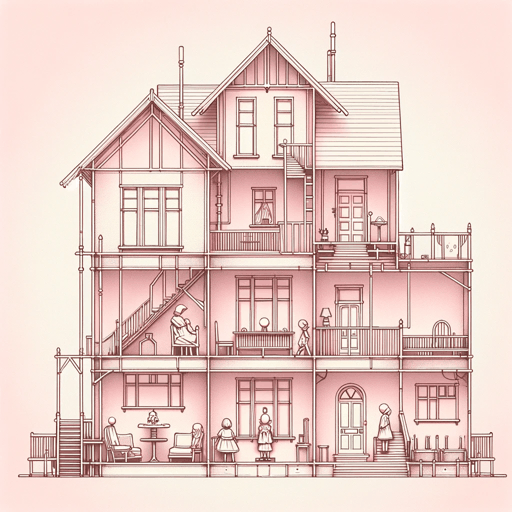
28 pages • 56 minutes read
A modern alternative to SparkNotes and CliffsNotes, SuperSummary offers high-quality Study Guides with detailed chapter summaries and analysis of major themes, characters, and more.
Story Analysis
Character Analysis
Symbols & Motifs
Literary Devices
Important Quotes
Essay Topics
Discussion Questions
The sisters and classmates demonstrate different modes of girlhood and femininity. To what extent does Kezia demonstrate conventional femininity?
Through free indirect discourse , Mansfield allows us to access several characters’ interiority. What is the rhetorical effect of juxtaposing adult consciousness alongside that of children?
Any toy that attracts the attention of young girls could have served as the eponymous focal point of this story. What specifically about the doll’s house elicits Mansfield’s biting social commentary? What function does this doll’s house perform, and what does it reveal about those who view it?

Don't Miss Out!
Access Study Guide Now
Related Titles
By Katherine Mansfield
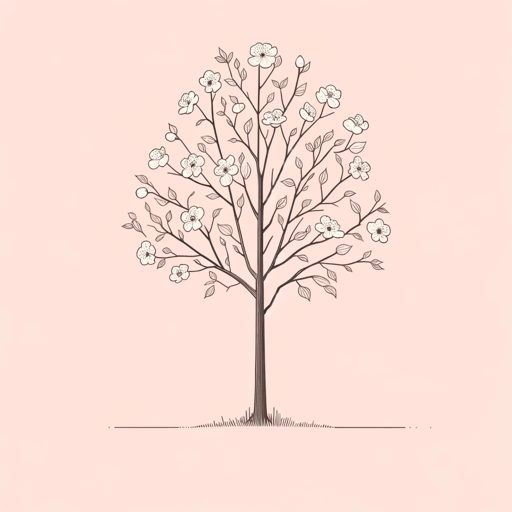
Katherine Mansfield

Her First Ball
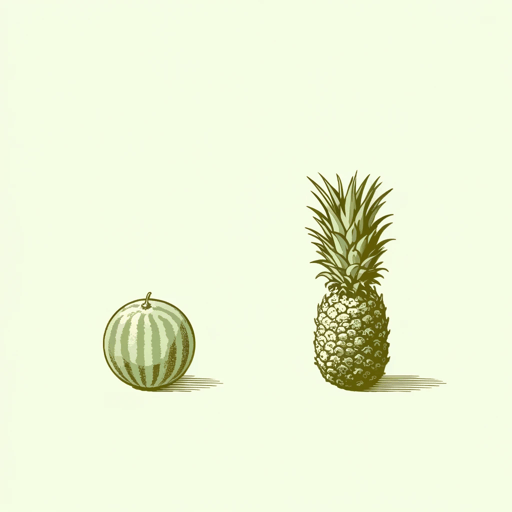
Marriage a la Mode
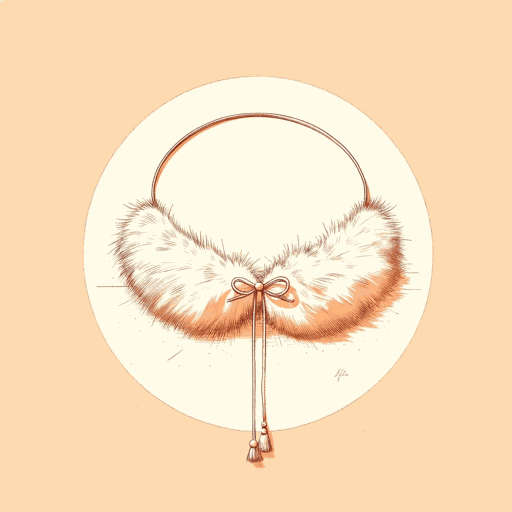
The Garden Party
Featured Collections
Books that Feature the Theme of...
View Collection
Childhood & Youth
The Doll's House
by Katherine Mansfield
The doll's house essay questions.
What is significant about the Burnell girls' school in "The Doll's House"?
"The Doll's House" uses the microcosm of the Burnell children's mixed-income school to illustrate how the economic divisions of class create barriers between people in a society—barriers that perpetuate hierarchical attitudes, prejudice, and ostracism. Social class is most apparent in the story through Mansfield's contrast of the economically and socially privileged lives of the Burnell children to the impoverished, underclass subsistence of the Kelveys. While the Burnells live in a large house with servants, special-occasion dresses, a servant-driven buggy that picks them up from school, and eat thick mutton sandwiches, the Kelveys wear clothes made from the Burnell's recycled tablecloth and eat jam sandwiches wrapped in newsprint. The Burnells' mother forbids her daughters from associating with the Kelveys, and the Burnells' social exclusion of the Kelveys is adopted by other students, thereby cementing the Kelveys' social ostracism. In this way, Mansfield shows how the class prejudice of the Burnells' mother leads to a recreation of the greater society's class hierarchy within the setting of the school.
What does the doll's house at the center of the story represent?
In "The Doll's House," the doll's house the Burnell children receive symbolizes social privilege. A gift from Mrs. Hay, a wealthy guest at the Burnells' home, the doll's house serves to elevate the Burnell girls' social status even higher within the social hierarchy of their mixed-income school. The eldest daughter Isabel understands that she can use the doll's house to enhance the aura of importance that already surrounds her. She intuitively knows that by only allowing two girls per day to see the doll's house, she can create a hierarchy of importance by determining who gets to see it first. In this way, Mansfield depicts how the privilege of owning the doll's house extends to the privilege of who gets to see the doll's house. Once every girl at school except the Kelveys has seen the doll's house, the hierarchy ceases to matter. However, privilege is still used as a weapon to separate everyone who has seen the doll's house from the only two who haven't because of their underclass status.
What is the significance of the little lamp in the doll's house?
The lamp on the dining table in the doll's house is a symbol of Kezia and Else's innocence. Kezia distinguishes herself from her sisters by zeroing in on the amber-colored lamp with the white globe when she and her sisters are first viewing the doll's house. Kezia admires how lifelike the lamp is, and marvels at how when she shakes it she discovers it is full of a liquid that emulates oil. When her sisters boast about the doll's house the next day at school, Isabel doesn't discuss the lamp with the emphasis Kezia believes it deserves. The lamp doesn't enter the story again until the end of the story when Else Kelvey tells her sister Lil, "I seen the little lamp." The line confirms that Else heard Kezia mention the lamp and was similarly enchanted by it when she finally saw the famous doll's house. In their shared appreciation of the little lamp, Else and Kezia are united in their innocence; they are the only characters who appreciate the doll's house for what it is and not the privileges it confers.

The Doll’s House Questions and Answers
The Question and Answer section for The Doll’s House is a great resource to ask questions, find answers, and discuss the novel.
Describe Kezia's act of kindness.
While swinging in her yard, Kezia sees the Kelveys walking down the road. As the Kelveys come nearer; their shadows stretch long, reaching across the road so that the shadows of their heads are in the buttercups. Kezia clambers back up the gate,...
Pat pried it open with his penknife, and the whole house front swung back, and—there you were, gazing at one and the same moment into the drawing-room and dining-room, the kitchen and two bedrooms.
Meaning, Pat used his penknife to open the side...
Who is described using animal images?
The Kelveys are described with animal images. The images serve as a symbol of their alienation from society.
Else: “a little white owl”.
The girls move “like two little stray cats”.
Beryl shoos the girls away “as if they were chickens."
Study Guide for The Doll’s House
The Doll's House study guide contains a biography of Katherine Mansfield, literature essays, quiz questions, major themes, characters, and a full summary and analysis.
- About The Doll's House
- The Doll's House Summary
- Character List
The Doll’s House by Katherine Mansfield
WHEN dear old Mrs. Hay went back to town after staying with the Burnells she sent the children a doll’s house. It was so big that the carter and Pat carried it into the courtyard, and there it stayed, propped up on two wooden boxes beside the feed-room door. No harm could come to it; it was summer. And perhaps the smell of paint would have gone off by the time it had to be taken in. For, really, the smell of paint coming from that doll’s house (‘ Sweet of old Mrs. Hay, of course ; most sweet and generous ! ‘)—but the smell of paint was quite enough to make anyone seriously ill, in Aunt Beryl’s opinion. Even before the sacking was taken off. And when it was…
There stood the Doll’s house, a dark, oily, spinach green, picked out with bright yellow. Its two solid little chimneys, glued on to the roof, were painted red and white, and the door, gleaming with yellow varnish, was like a little slab of toffee. Four windows, real windows, were divided into panes by a broad streak of green. There was actually a tiny porch, too, painted yellow, with big lumps of congealed paint hanging along the edge.
But perfect, perfect little house! Who could possibly mind the smell. It was part of the joy, part of the newness.
” Open it quickly, someone ! ”
The hook at the side was stuck fast. Pat prized it open with his penknife, and the whole house front swung back, and—there you were, gazing at one and the same moment into the drawing-room and dining-room, the kitchen and two bedrooms. That is the way for a house to open ! Why don’t all houses open like that ? How much more exciting than peering through the slit of a door into a mean little hall with a hatstand and two umbrellas! That is—isn’t it ?—what you long to know about a house when you put your hand on the knocker. Perhaps it is the way God opens houses at the dead of night when He is taking a quiet turn with an angel…
” O-oh! ” The Burnell children sounded as though they were in despair. It was too marvellous ; it was too much for them. They had never seen anything like it in their lives. All the rooms were papered. There were pictures on the walls, painted on the paper, with gold frames complete. Red carpet covered all the floors except the kitchen ; red plush chairs in the drawing-room, green in the dining-room; tables, beds with real bedclothes, a cradle, a stove, a dresser with tiny plates and one big jug. But what Kezia liked more than anything, what she liked frightfully”, was the lamp. It stood in the middle of the dining-room table, an exquisite little amber lamp with a white globe. It was even filled all ready for lighting, though, of course, you couldn’t light it. But there was something inside that looked like oil and moved when you shook it.
The father and mother dolls, who sprawled very stiff as though they had fainted in the drawing-room, and their two little children asleep upstairs, were really too big for the doll’s house. They didn’t look as though they belonged. But the lamp was perfect. It seemed to smile at Kezia, to say, ” I live here.” The lamp was real.
The Burnell children could hardly walk to school fast enough the next morning. They burned to tell everybody, to describe, to—well —to boast about their doll’s house before the school-bell rang.
” I’m to tell,” said Isabel, ” because I’m the eldest. And you two can join in after. But I’m to tell first.”
There was nothing to answer. Isabel was bossy, but she was always right, and Lottie and Kezia knew too well the powers that went with being eldest. They brushed through the thick buttercups at the road edge and said nothing.
” And I’m to choose who’s to come and see it first. Mother said I might.”
For it had been arranged that while the doll’s house stood in the courtyard they might ask the girls at school, two at a time, to come and look. Not to stay to tea, of course, or to come traipsing through the house. But just to stand quietly in the courtyard while Isabel pointed out the beauties, and Lottie and Kezia looked pleased…
But hurry as they might, by the time they had reached the tarred palings of the boys’ playground the bell had begun to jangle. They only just had time to whip off their hats and fall into line before the roll was called. Never mind. Isabel tried to make up for it by looking very important and mysterious and by whispering behind her hand to the girls near her, ” Got something to tell you at playtime.”
Playtime came and Isabel was surrounded. The girls of her class nearly fought to put their arms round her, to walk away with her, to beam flatteringly, to be her special friend. She held quite a court under the huge pine trees at the side of the playground. Nudging, giggling together, the little girls pressed up close. And the only two who stayed outside the ring were the two who were always outside, the little Kelveys. They knew better than to come anywhere near the Burnells.
For the fact was, the school the Burnell children went to was not at all the kind of place their parents would have chosen if there had been any choice. But there was none. It was the only school for miles. And the consequence was all the children of the neighbourhood, the Judge’s little girls, the doctor’s daughters, the store-keeper’s children, the milkman’s, were forced to mix together. Not to speak of there being an equal number of rude, rough little boys as well. But the line had to be drawn somewhere. It was drawn at the Kelveys. Many of the children, including the Burnells, were not allowed even to speak to them. They walked past the Kelveys with their heads in the air, and as they set the fashion in all matters of behaviour, the Kelveys were shunned by everybody. Even the teacher had a special voice for them, and a special smile for the other children when Lil Kelvey came up to her desk with a bunch of dreadfully common-looking flowers.
They were the daughters of a spry, hardworking little washerwoman, who went about from house to house by the day. This was awful enough. But where was Mr. Kelvey ? Nobody knew for certain. But everybody said he was in prison. So they were the daughters of a washerwoman and a gaolbird. Very nice company for other people’s children! And they looked it. Why Mrs. Kelvey made them so conspicuous was hard to understand. The truth was they were dressed in ” bits ” given to her by the people for whom she worked. Lil, for instance, who was a stout, plain child, with big freckles, came to school in a dress made from a green art-serge table-cloth of the Burnells’, with red plush sleeves from the Logans’ curtains. Her hat, perched on top of her high forehead, was a grown-up woman’s hat, once the property of Miss Lecky, the postmistress. It was turned up at the back and trimmed with a large scarlet quill. What a little guy she looked ! It was impossible not to laugh. And her little sister, our Else, wore a long white dress, rather like a nightgown, and a pair of little boy’s boots. But whatever our Else wore she would have looked strange. She was a tiny wishbone of a child, with cropped hair and enormous solemn eyes—a little white owl. Nobody had ever seen her smile ; she scarcely ever spoke. She went through life holding on to Lil, with a piece of Lil’s skirt screwed up in her hand. Where Lil went, our Else followed. In the playground, on the road going to and from school, there was Lil marching in front and our Else holding on behind. Only when she wanted anything, or when she was out of breath, our Else gave Lil a tug, a twitch, and Lil stopped and turned round. The Kelveys never failed to understand each other.
Now they hovered at the edge ; you couldn’t stop them listening. When the little girls turned round and sneered, Lil, as usual, gave her silly, shamefaced smile, but our Else only looked.
And Isabel’s voice, so very proud, went on telling. The carpet made a great sensation, but so did the beds with real bedclothes, and the stove with an oven door.
When she finished Kezia broke in. ” You’ve forgotten the lamp, Isabel.”
” Oh, yes,” said Isabel, ” and there’s a teeny little lamp, all made of yellow glass, with a white globe that stands on the dining-room table. You couldn’t tell it from a real one.”
” The lamp’s best of all,” cried Kezia. She thought Isabel wasn’t making half enough of the little lamp. But nobody paid any attention. Isabel was choosing the two who were to come back with them that afternoon and see it. She chose Emmie Cole and Lena Logan. But when the others knew they were all to have a chance, they couldn’t be nice enough to Isabel. One by one they put their arms round Isabel’s waist and walked her off. They had something to whisper to her, a secret. ” Isabel’s my friend.”
Only the little Kelveys moved away forgotten ; there was nothing more for them to hear.
Days passed, and as more children saw the doll’s house, the fame of it spread. It became the one subject, the rage. The one question was, ” Have you seen Burnells’ doll’s house ? Oh, ain’t it lovely ! ” ” Haven’t you seen it ? Oh, I say ! ”
Even the dinner hour was given up to talking about it. The little girls sat under the pines eating their thick mutton sandwiches and big slabs of johnny cake spread with butter. While always, as near as they could get, sat the Kelveys, our Else holding on to Lil, listening too, while they chewed their jam sandwiches out of a newspaper soaked with large red blobs. ” Mother,” said Kezia, ” can’t I ask the Kelveys just once ? ”
” Certainly not, Kezia.”
” But why not ? ”
” Run away, Kezia ; you know quite well why not.”
At last everybody had seen it except them. On that day the subject rather flagged. It was the dinner hour. The children stood together under the pine trees, and suddenly, as they looked at the Kelveys eating out of their paper, always by themselves, always listening, they wanted to be horrid to them. Emmie Cole started the whisper.
” Lil Kelvey’s going to be a servant when she grows up.”
” O-oh, how awful! ” said Isabel Burnell, and she made eyes at Emmie.
Emmie swallowed in a very meaning way and nodded to Isabel as she’d seen her mother do on those occasions.
” It’s true—it’s true—it’s true,” she said.
Then Lena Logan’s little eyes snapped. ” Shall I ask her ? ” she whispered.
” Bet you don’t,” said Jessie May.
” Pooh, I’m not frightened,” said Lena. Suddenly she gave a little squeal and danced in front of the other girls. ” Watch! Watch me ! Watch me now! ” said Lena. And sliding, gliding, dragging one foot, giggling behind her hand, Lena went over to the Kelveys.
Lil looked up from her dinner. She wrapped the rest quickly away. Our Else stopped chewing. What was coming now ?
” Is it true you’re going to be a servant when you grow up, Lil Kelvey ? ” shrilled Lena.
Dead silence. But instead of answering, Lil only gave her silly, shamefaced smile. She didn’t seem to mind the question at all. What a sell for Lena ! The girls began to titter.
Lena couldn’t stand that. She put her hands on her hips; she shot forward. ” Yah, yer father’s in prison ! ” she hissed, spitefully.
This was such a marvellous thing to have said that the little girls rushed away in a body, deeply, deeply excited, wild with joy. Someone found a long rope, and they began skipping. And never did they skip so high, run in and out so fast, or do such daring things as on that morning.
In the afternoon Pat called for the Burnell children with the buggy and they drove home. There were visitors. Isabel and Lottie, who liked visitors, went upstairs to change their pinafores. But Kezia thieved out at the back. Nobody was about; she began to swing on the big white gates of the courtyard. Presently, looking along the road, she saw two little dots. They grew bigger, they were coming towards her. Now she could see that one was in front and one close behind. Now she could see that they were the Kelveys. Kezia stopped swinging. She slipped off the gate as if she was going to run away. Then she hesitated. The Kelveys came nearer, and beside them walked their shadows, very long, stretching right across the road with their heads in the buttercups. Kezia clambered back on the gate ; she had made up her mind ; she swung out.
” Hullo,” she said to the passing Kelveys.
They were so astounded that they stopped. Lil gave her silly smile. Our Else stared.
” You can come and see our doll’s house if you want to,” said Kezia, and she dragged one toe on the ground. But at that Lil turned red and shook her head quickly.
” Why not ? ” asked Kezia.
Lil gasped, then she said, ” Your ma told our ma you wasn’t to speak to us.”
” Oh, well,” said Kezia. She didn’t know what to reply. ” It doesn’t matter. You can come and see our doll’s house all the same. Come on. Nobody’s looking.”
But Lil shook her head still harder.
” Don’t you want to ? ” asked Kezia.
Suddenly there was a twitch, a tug at Lil’s skirt. She turned round. Our Else was looking at her with big, imploring eyes ; she was frowning ; she wanted to go. For a moment Lil looked at our Else very doubtfully. But then our Else twitched her skirt again. She started forward. Kezia led the way. Like two little stray cats they followed across the courtyard to where the doll’s house stood.
” There it is,” said Kezia.
There was a pause. Lil breathed loudly, almost snorted ; our Else was still as stone.
” I’ll open it for you,” said Kezia kindly. She undid the hook and they looked inside.
” There’s the drawing-room and the dining-room, and that’s the——”
” Kezia ! ”
Oh, what a start they gave !
“Kezia!”
It was Aunt Beryl’s voice. They turned round. At the back door stood Aunt Beryl, staring as if she couldn’t believe what she saw.
” How dare you ask the little Kelveys into the courtyard ? ” said her cold, furious voice. ” You know as well as I do, you’re not allowed to talk to them. Run away, children, run away at once. And don’t come back again,” said Aunt Beryl. And she stepped into the yard and shooed them out as if they were chickens.
” Off you go immediately! ” she called, cold and proud.
They did not need telling twice. Burning with shame, shrinking together, Lil huddling along like her mother, our Else dazed, somehow they crossed the big courtyard and squeezed through the white gate.
” Wicked, disobedient little girl! ” said Aunt Beryl bitterly to Kezia, and she slammed the doll’s house to.
The afternoon had been awful. A letter had come from Willie Brent, a terrifying, threatening letter, saying if she did not meet him that evening in Pulman’s Bush, he’d come to the front door and ask the reason why! But now that she had frightened those little rats of Kelveys and given Kezia a good scolding, her heart felt lighter. That ghastly pressure was gone. She went back to the house humming.
When the Kelveys were well out of sight of Burnells’, they sat down to rest on a big red drainpipe by the side of the road. Lil’s cheeks were still burning ; she took off the hat with the quill and held it on her knee. Dreamily they looked over the hay paddocks, past the creek, to the group of wattles where Logan’s cows stood waiting to be milked. What were their thoughts? Presently our Else nudged up close to her sister. But now she had forgotten the cross lady. She put out a finger and stroked her sister’s quill; she smiled her rare smile.
” I seen the little lamp,” she said, softly.
Then both were silent once more.
More from Katherine Mansfield :
- The Lady’s Maid
- The Young Girl
- The Doll’s House
- The Daughters of the Late Colonel

You are here
Mcconnell mansion museum, mcconnell house.
- Location: Moscow Idaho Regional Essays: Idaho Latah County Architect: William McConnell Types: single-family dwellings boardinghouses historic house museums (buildings) bay windows brackets (structural elements) Styles: Italianate (North American architecture styles) Eastlake Materials: clapboard siding millwork aluminum (metal)
What's Nearby
Wendy R. McClure, " McConnell Mansion Museum ", [ Moscow , Idaho ], SAH Archipedia, eds. Gabrielle Esperdy and Karen Kingsley, Charlottesville: UVaP, 2012—, http://sah-archipedia.org/buildings/ID-01-057-0001-01 . Last accessed: April 22, 2024.
Permissions and Terms of Use
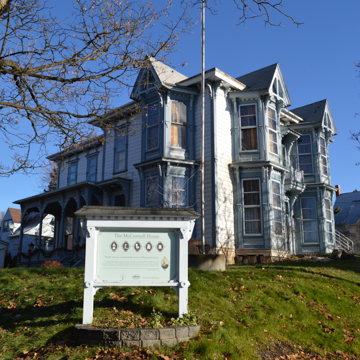
In 1886, entrepreneur William E. McConnell began building a two-story house, sunken garden, small carriage house, and barn for his family on an entire block in the Fort Russell neighborhood. Like other early Fort Russell residents, McConnell sited the house on the block’s most prominent corner, the intersection of Second and Adams streets, to showcase its eyecatching design and position his family at the center of Moscow’s social life.
The house reflects an eclectic blend of Victorian-era architectural styles including Eastlake, Italianate, and Gothic Revival. Rather than engage an architect, McConnell likely used plans from a pattern book and worked with a carpenter to integrate elements and detailing from the three styles. The resulting cohesive design made a unique statement in the fledgling city.
On the exterior, characteristically vertical proportions are expressed in several ways. Three two-story bays capped with slender gable roofs define its signature massing; windows and doors on each facade are correspondingly tall and narrow. As viewed from intersecting sidewalks and streets, verticality is further amplified by the site itself, which slopes steeply upward toward the house. Exterior ornamentation is extensive: decorative brackets support window bays and roof overhangs, and gable ends feature highly articulated wood ornamentation. Although the original clapboard siding has been replaced with metal siding, gable ends continue to display cedar shingles with sawtooth imbrication.
Both the spatial organization and interior detailing reflect a combination of Victorian-era influences. The original ground-floor plan featured front and rear parlors separated by wood sliding doors, a dining room, kitchen, pantry, and servant’s quarters. Four bedrooms and children’s playrooms were housed on the second floor. High ceiling heights prevail throughout the house. Windows feature interior wooden shutters (made in San Francisco) that serve to further accent vertical proportions in each room.
Consistent with the later Victorian era, appearance rather than quality weighed heavily McConnell’s decisions regarding finishes. Interior detailing was largely crafted from Moscow’s limited pallet of available materials. Locally prevalent fir and pine were used for interior millwork and flooring; the inexpensive wood was then painted with graining to create the appearance of more costly hardwoods. Similarly, the steel-backed fireplace in the back parlor was embellished with a thin veneer of Vermont marble bordered by gold leaf and black onyx trim.
The family fell into financial hard times following McConnell’s two-term governorship and the financial panic of 1893, during which he was forced to declare bankruptcy and close his downtown department store. To avoid losing the property, McConnell’s wife declared it an official homestead. The bank took ownership of the house in 1897 and it remained vacant until 1901, when it was purchased by William Adair, one of the community’s first physicians. Since the house was larger than his family required, Adair rented rooms to local entrepreneurs and university faculty. Frederic Church, a European history professor who, at one time, rented a room in the house, later purchased the building as his own single-family residence. The barn was sold and converted to a single-family residence in 1926. Church bequeathed the house to the Latah County Historical Society upon his death in 1966.
Since 1968 the house has served as both headquarters and museum for the Latah County Historical Society (LCHS). It provides one of the best remaining examples of Italianate and Eastlake architecture in the state of Idaho. Though compromised by some unfortunate decisions surrounding its ongoing maintenance, such as use of metal replacement siding, the McConnell House continues to communicate a significant architectural presence while serving in its adapted role as a museum.
Doyon, Annie, and Kathryn Burke-Hise, “Fort Russell Neighborhood Historic District,” Latah County, Idaho. National Register of Historic Places District Boundary Increase and Additional Documentation, 2015. National Park Service, U.S. Department of the Interior, Washington D.C.
Monroe, J. Moscow: Living and Learning on the Palouse . Charleston, SC: Arcadia Publishing, 2003.
Otness, L. A Great Good Country: A Guide to Historic Moscow and Latah County, Idaho . Moscow, ID: Local History Paper # 8, Latah County Historical Society, 1983.
Renk, Nancy. “W.E. McConnell House,” Latah County, Idaho. National Register of Historic Places Registration Form, 1974. National Park Service, U.S. Department of the Interior, Washington D.C.
Writing Credits
- Location: Moscow, Idaho Regional Overviews: Latah County Architect: William McConnell Types: single-family dwellings boardinghouses historic house museums (buildings) bay windows brackets (structural elements) Styles: Italianate (North American architecture styles) Eastlake Materials: clapboard siding millwork aluminum (metal)
If SAH Archipedia has been useful to you, please consider supporting it.
SAH Archipedia tells the story of the United States through its buildings, landscapes, and cities. This freely available resource empowers the public with authoritative knowledge that deepens their understanding and appreciation of the built environment. But the Society of Architectural Historians, which created SAH Archipedia with University of Virginia Press, needs your support to maintain the high-caliber research, writing, photography, cartography, editing, design, and programming that make SAH Archipedia a trusted online resource available to all who value the history of place, heritage tourism, and learning.
- Bahasa Indonesia
- Slovenščina
- Science & Tech
- Russian Kitchen
The most fairy-tale houses of old Moscow (PHOTOS)
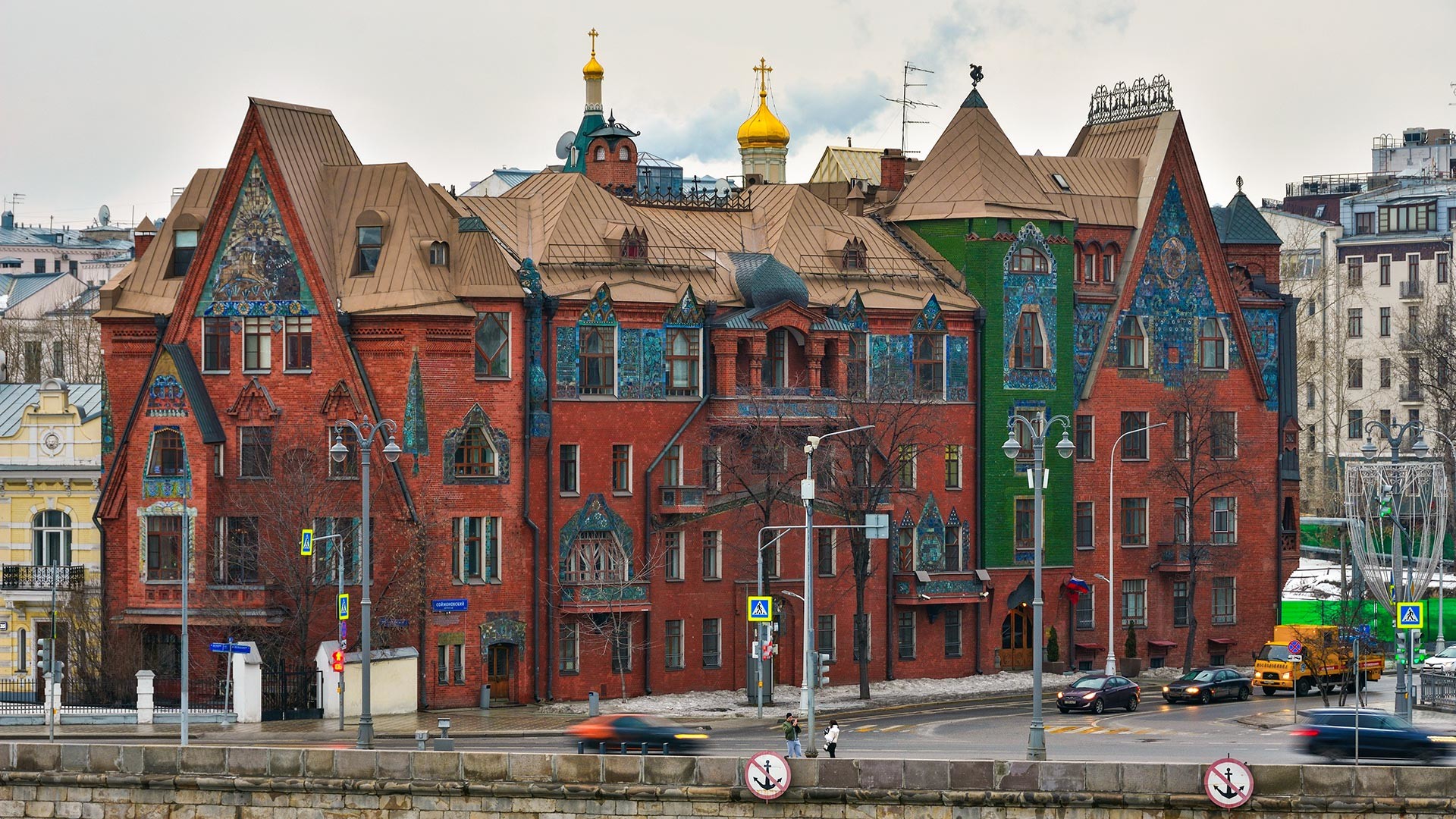
The Pertsova House
At the turn of the last century, Russia was gripped with a trend for reviving medieval Russian art and heritage sites. Artists and architects found a new appreciation for the uniqueness and artistic value of old Russian icons and architecture. They began to incorporate images and elements of Old Rus into their works, while at the same time re-imagining them. Medieval Russian art was the strongest influence on the Russian avant-garde. In architecture, the emergence of this Russian style (also referred to as the neo-Russian or pseudo-Russian style) was further bolstered by the lifting of strict regulations governing building design, as well as by several industrial exhibitions in Moscow, St. Petersburg and Paris that featured houses and interiors inspired by medieval Russian architecture. Subsequently, buildings and entire neighborhoods built according to these designs began to appear in many cities in Russia and beyond.

GUM and the Historical Museum
The Russian style consists of fashioning modern buildings on the wooden architecture of Slavic masters, sometimes deliberately exaggerating their most pronounced features. The most famous Russian style buildings in Moscow are the GUM department store in Red Square, the Yaroslavsky and Kazansky railway stations, and the Historical Museum in Manezhnaya Square. In addition, Moscow has preserved several unique mansions that look like they came right off the pages of a book of Russian folk tales.
1. The Lopatina Mansion, 1876
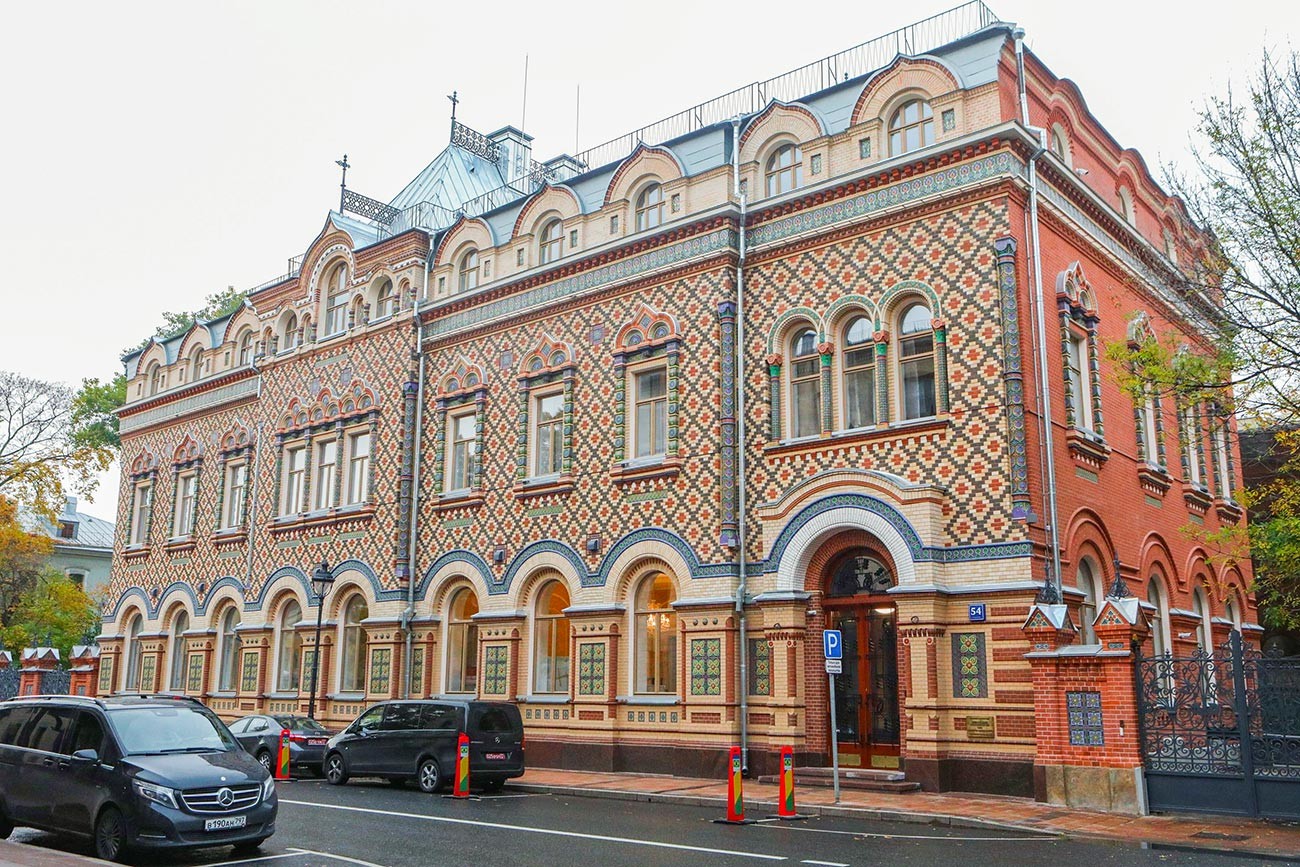
This house decorated with colorful mosaics is located in the very center of Moscow on Bolshaya Nikitskaya street. Before the Bolshevik Revolution, it belonged to Anna Lopatina, who ran a business that supplied seafood to Moscow. In addition to the owners' apartment, the building contained apartments that were rented out as well as warehouses and administrative offices on the ground floor.
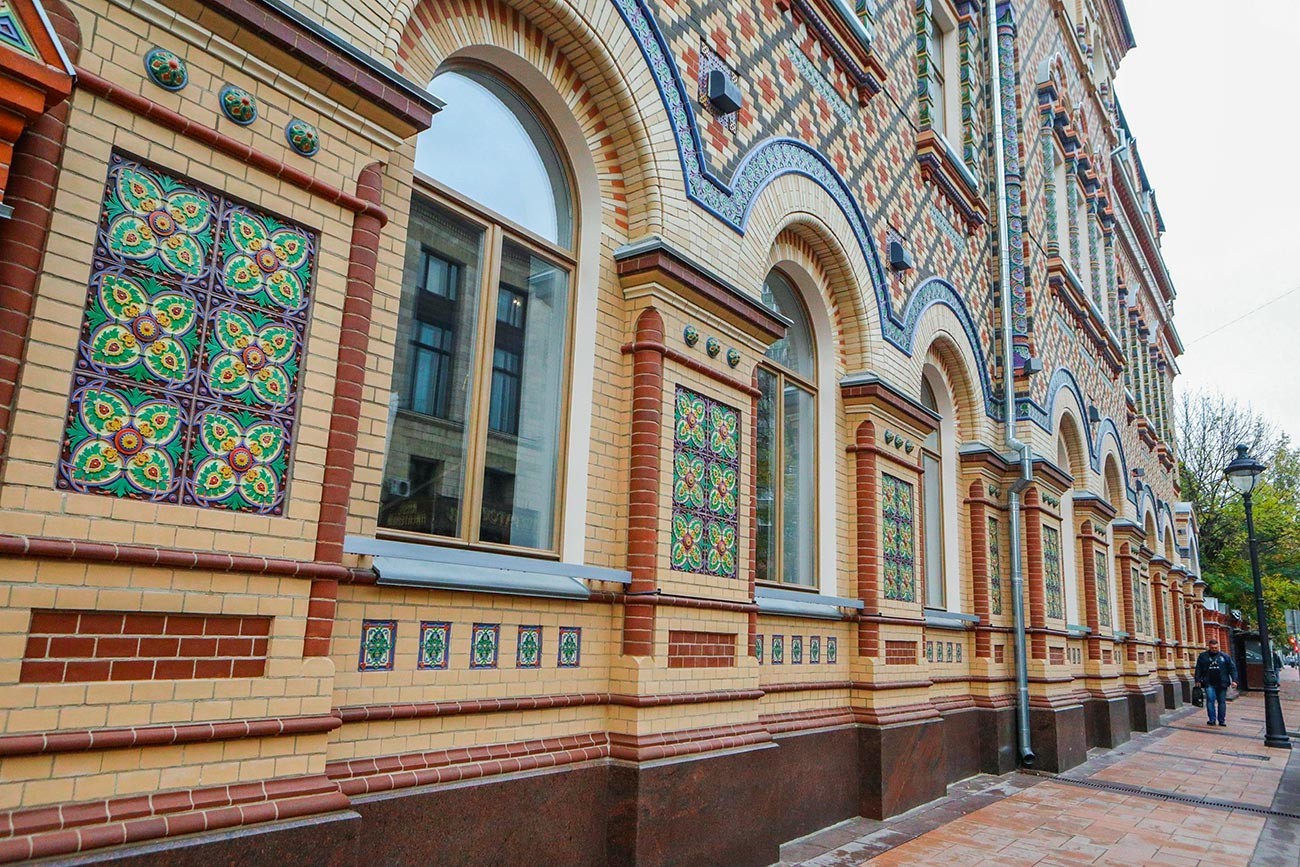
The building was designed by architect Alexander Kaminsky, the son-in-law of Pavel Tretyakov, who founded the Tretyakov Gallery—which was also built in the Russian style. Kaminsky decorated its facade with an ornament made of small multi-colored bricks and ceramics resembling cross-stitch, while the design for its arched windows was borrowed from boyar chambers.
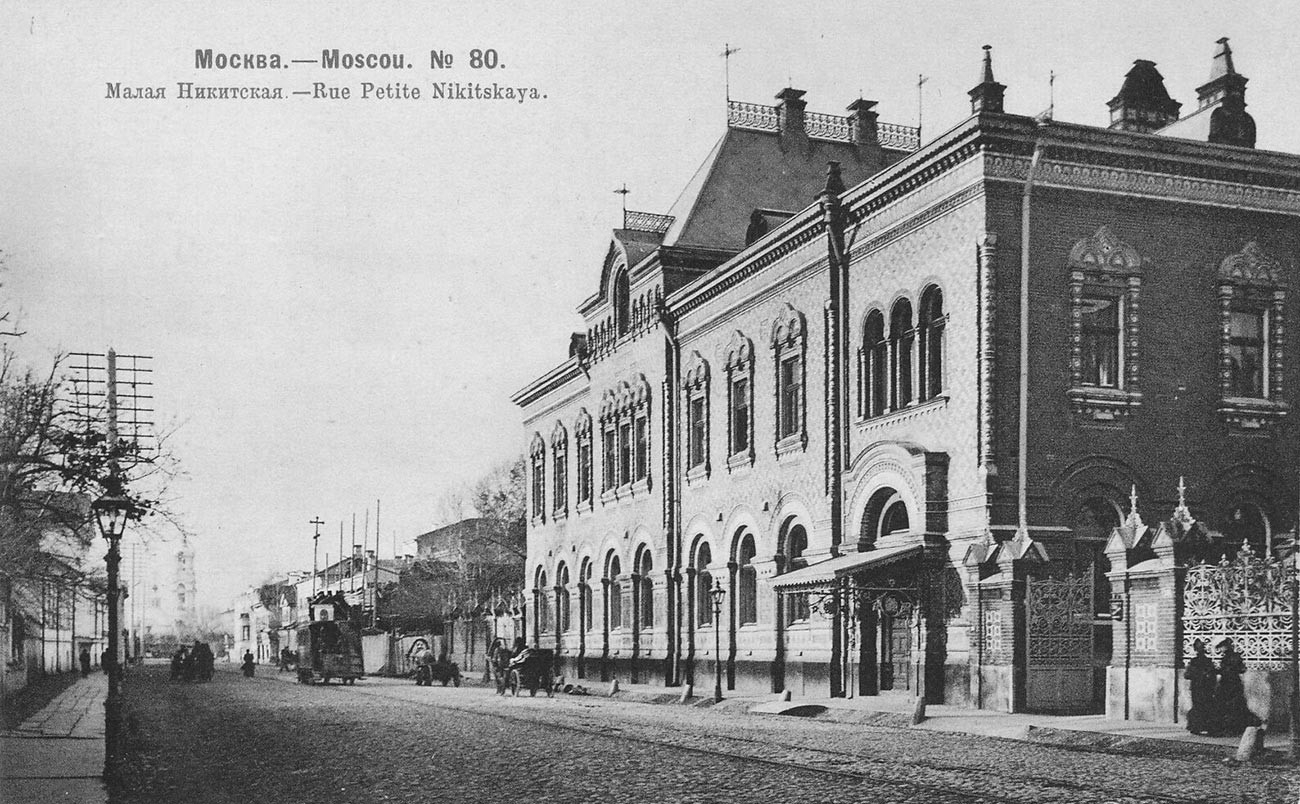
The third floor was added in the 1920s, when the mansion passed into the hands of the Soviet authorities and was turned into a residence hall. These days it houses the Brazilian Embassy.
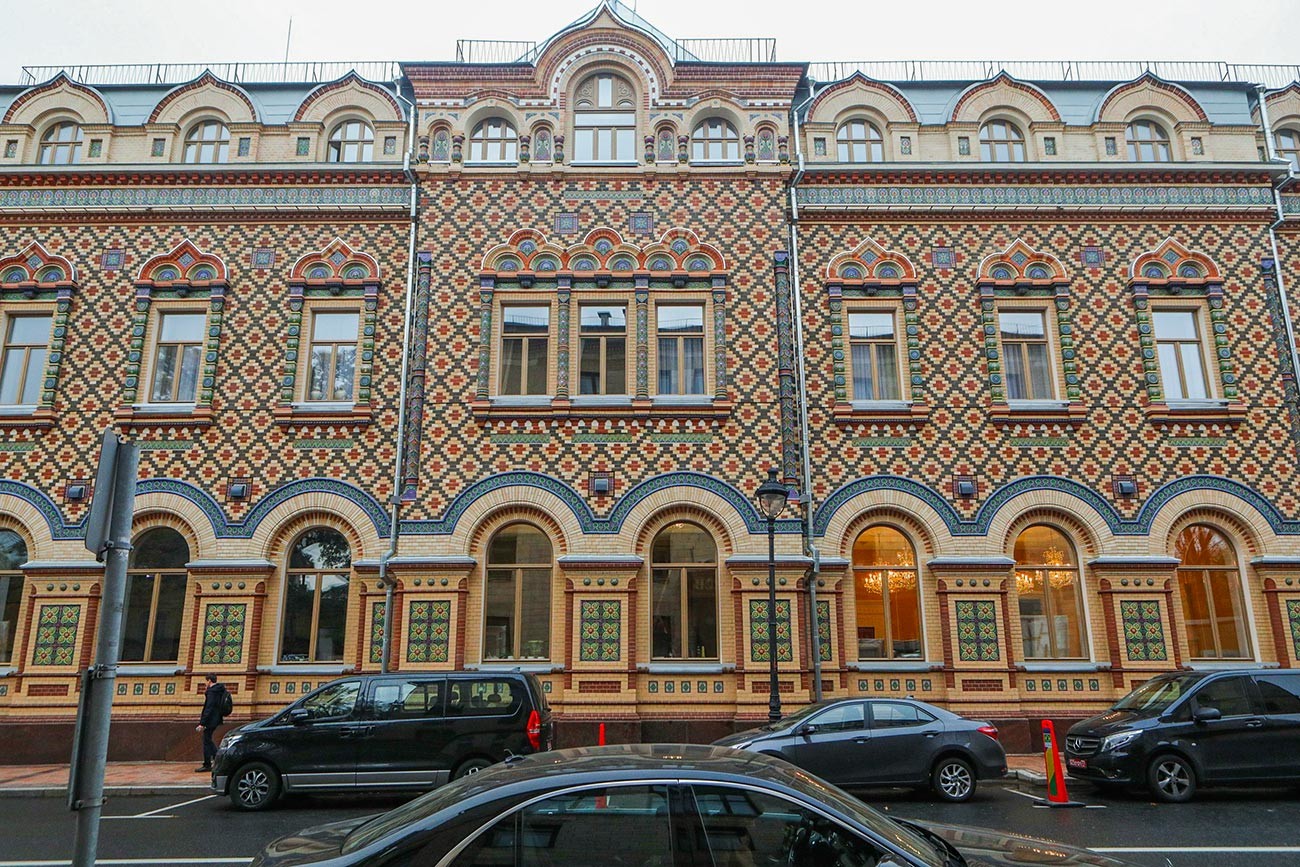
2. The Tsvetkov House, 1899-1901
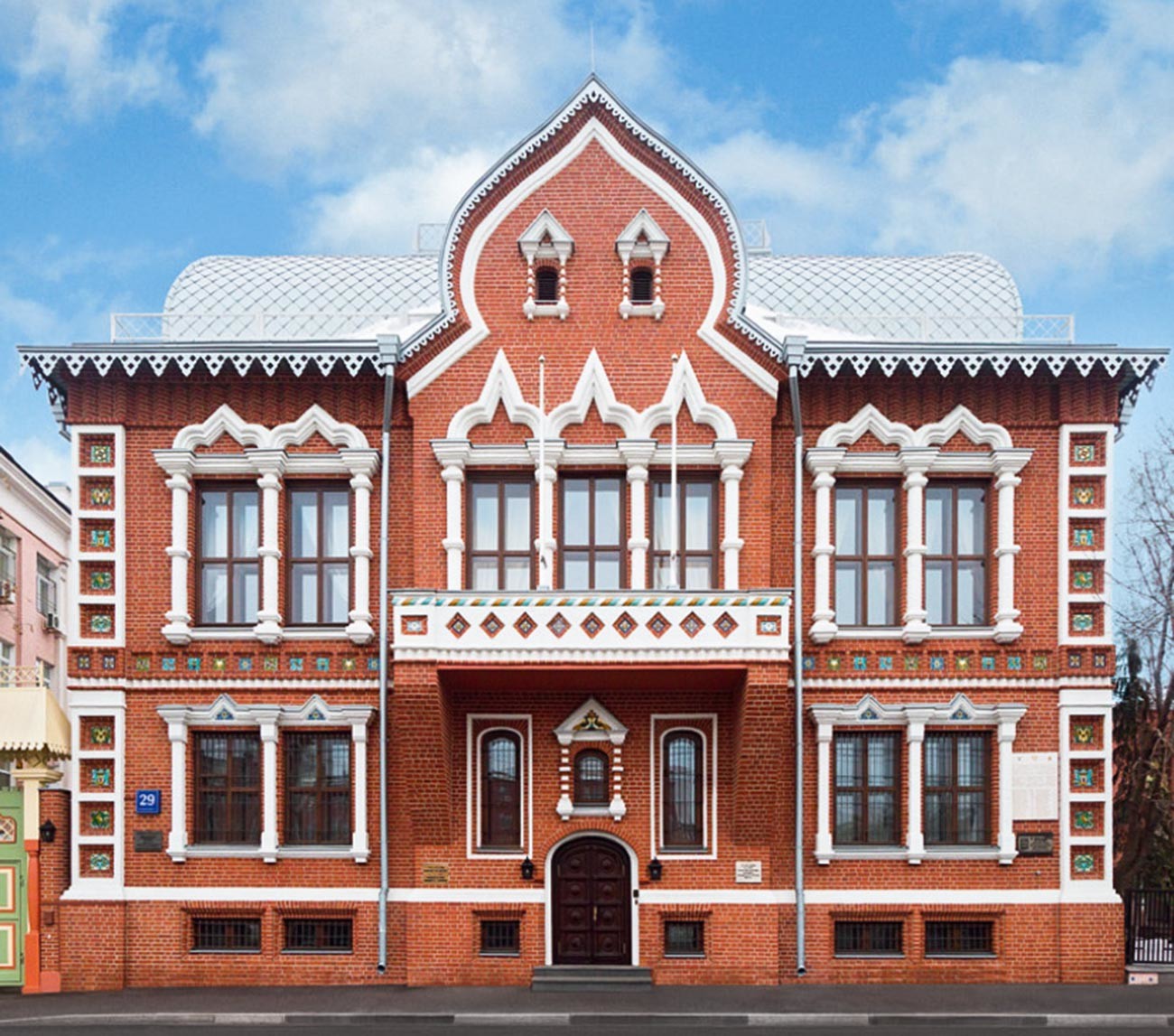
This small house on Prechistenskaya Embankment was commissioned by the art collector Ivan Tsvetkov. He was a devoted admirer of Russian art and planned this mansion as an art gallery, having hired artist Viktor Vasnetsov (author of The Bogatyrs and Alyonushka) to create its architectural design. The result was a house that was canonically “Russian” both from the outside and on the inside.
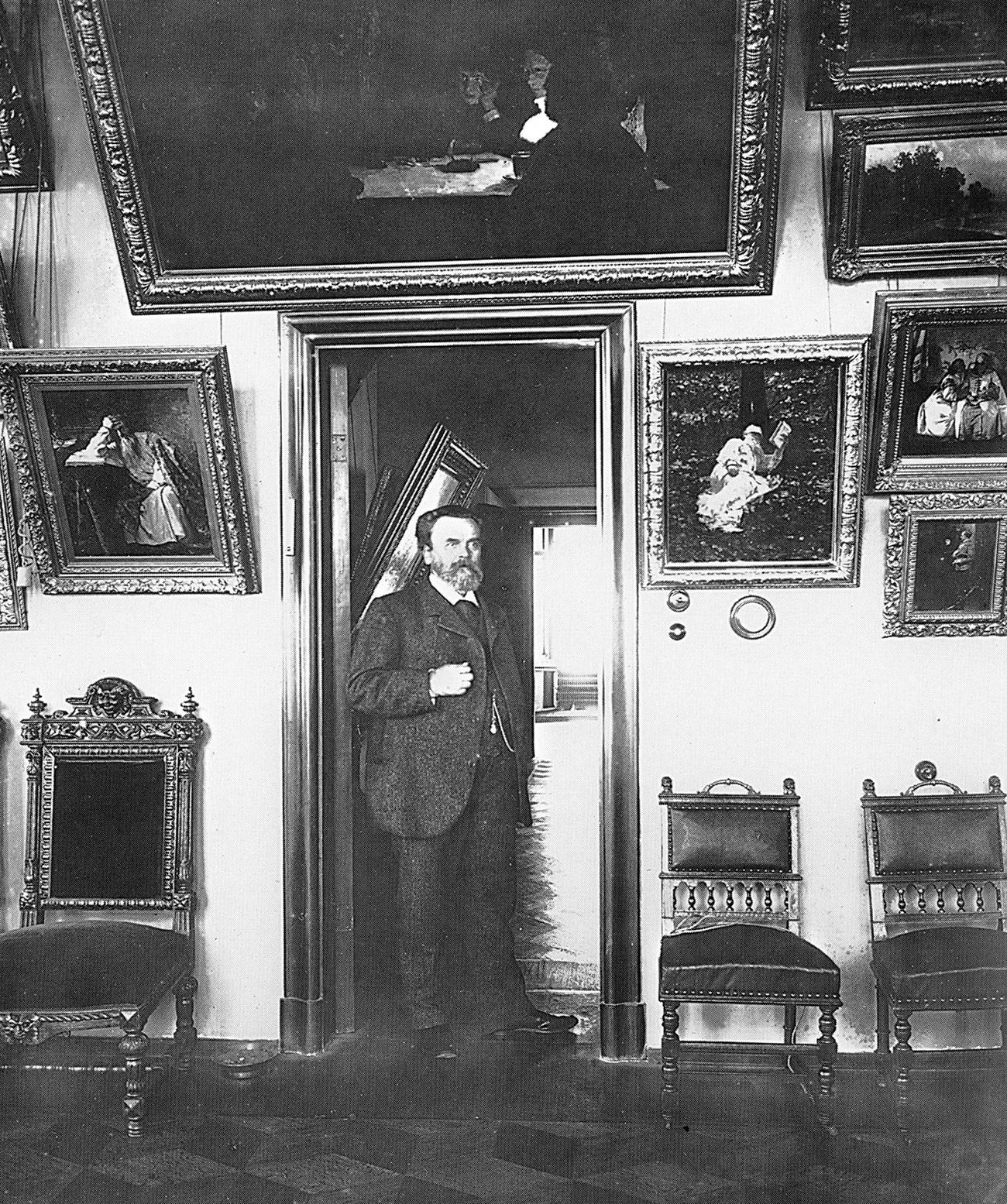
Ivan Tsvetkov in his gallery.
It features a domed roof above carved stone balconies, bright tiles on the lintels, rooms with massive censer-like chandeliers and wooden chest benches. The view from the house opened to the Krasny Oktyabr confectionery factory (which at the time was called Einem).

In 1909, Tsvetkov donated the house and his extensive collection of paintings (including more than 1,800 canvases and sculptures) to the city, while retaining the right to live in the house and rebuild the gallery. After his death in August 1917, the building was turned into an art museum and even served as a branch of the Tretyakov Gallery for some time.
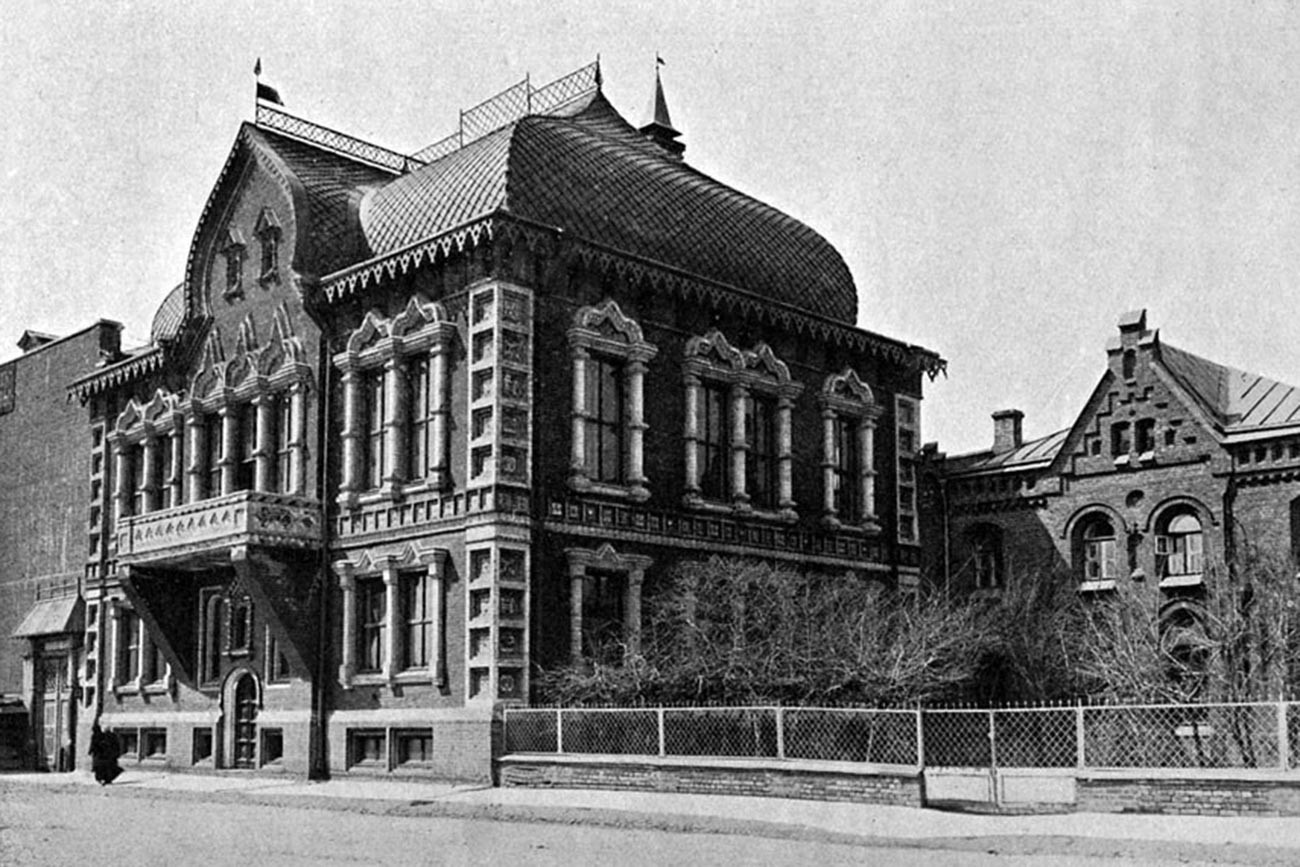
In the 1930s, however, the collection was distributed among regional museums, while the house itself was converted into a residence hall. During the war, the building was home to the headquarters of the Normandie-Niemen Fighter Regiment. Currently, it is used as a foreign diplomatic residence.

3. The Pertsova House, 1905-1907
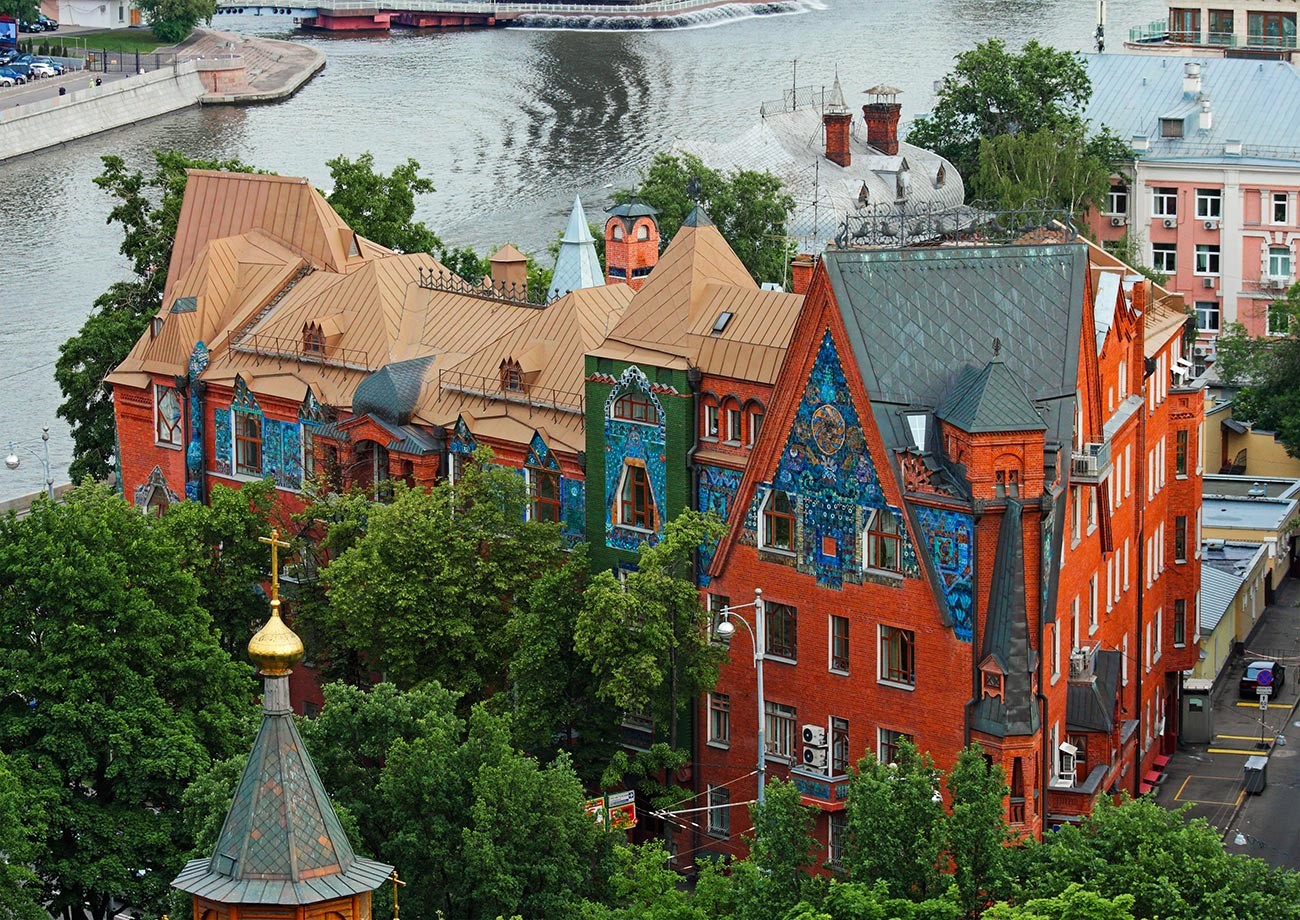
This fairy tale house on Prechistenskaya Embankment is one of the most striking buildings in Moscow. It was commissioned by a railroad engineer named Pyotr Pertsov, who registered the house in the name of his wife Zinaida. Pertsov became obsessed with the idea of building a mansion in the Russian style after visiting his friend Ivan Tsvetkov.

A plot of land was available nearby, and this is where Pertsov built his apartment building. A huge fan of Russian art, he planned to rent out apartments in the building to artists, writers and other members of the creative class at a very modest price. The house was designed by the architect Sergei Malyutin—designer of the famous Russian nesting doll—who deliberately included windows of different sizes and asymmetric facades. The attics housed workshops, and inside there were elevators and even a telephone.
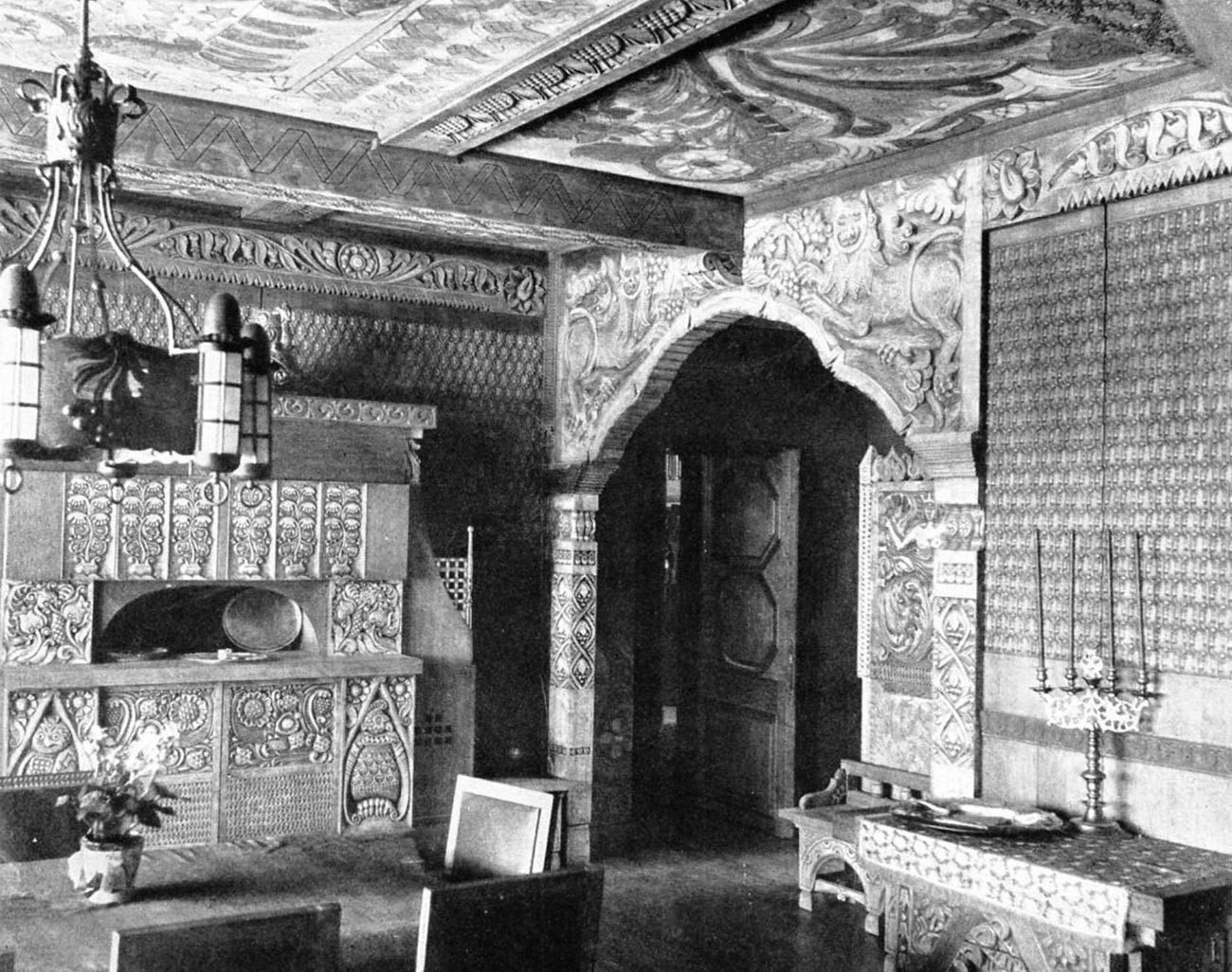
The owners' apartment occupied four floors in a separate wing and was stylized as a Russian hut, complete with tiled stoves, carved oak furniture and stained-glass windows. The house became a popular meeting place for Moscow's art scene. There was a cabaret in the basement, and passers-by would often stop outside this mansion to admire the intricate details of its facade.
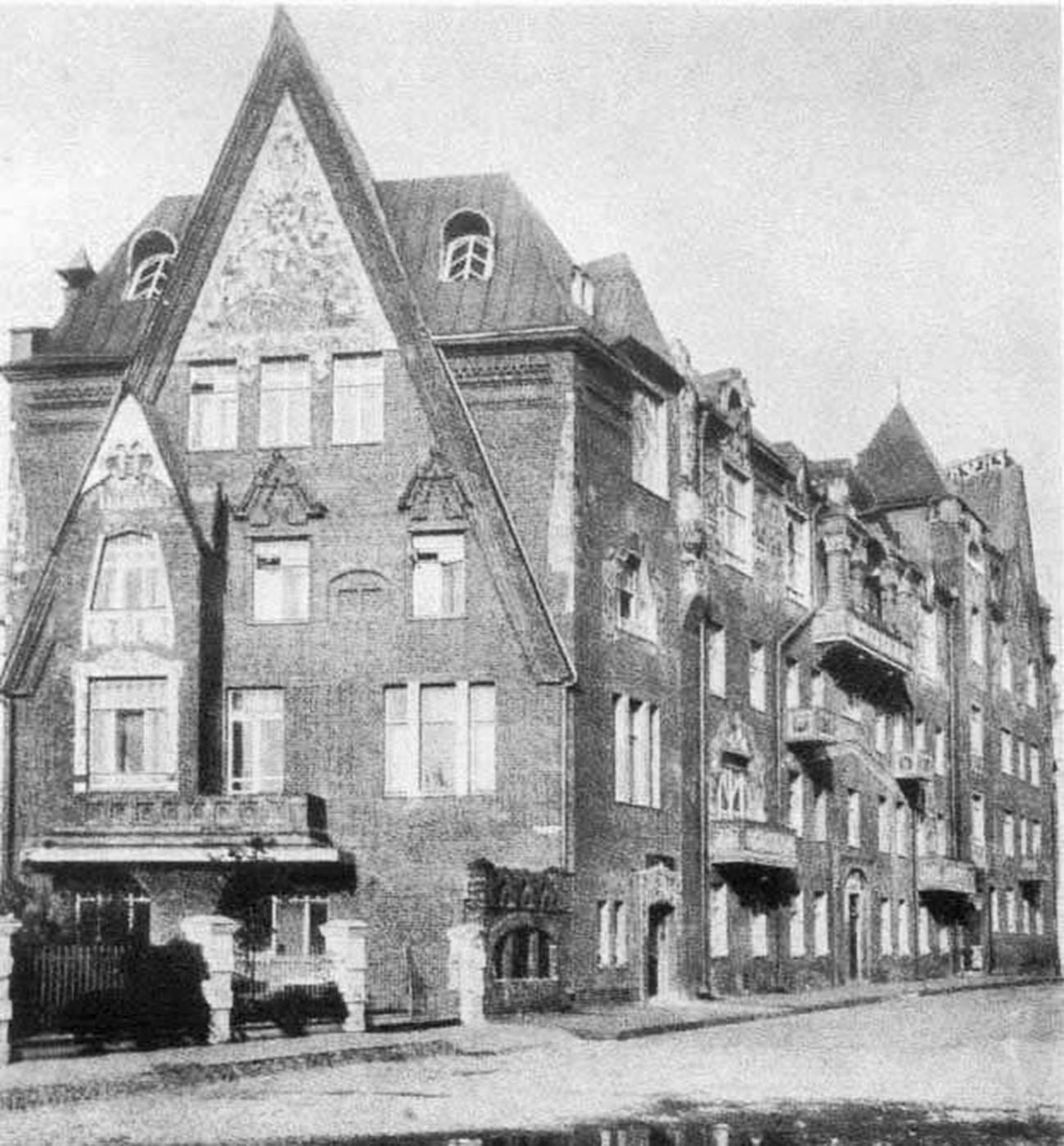
After the Bolshevik Revolution, the house was nationalized, and representatives of the new government moved in, including Leon Trotsky. Most of the original interior decoration has been lost over the years, but on the outside the building has changed very little. Since the 1970s, the mansion has been used by the Foreign Ministry.
4. The Igumnov House, 1888-1895
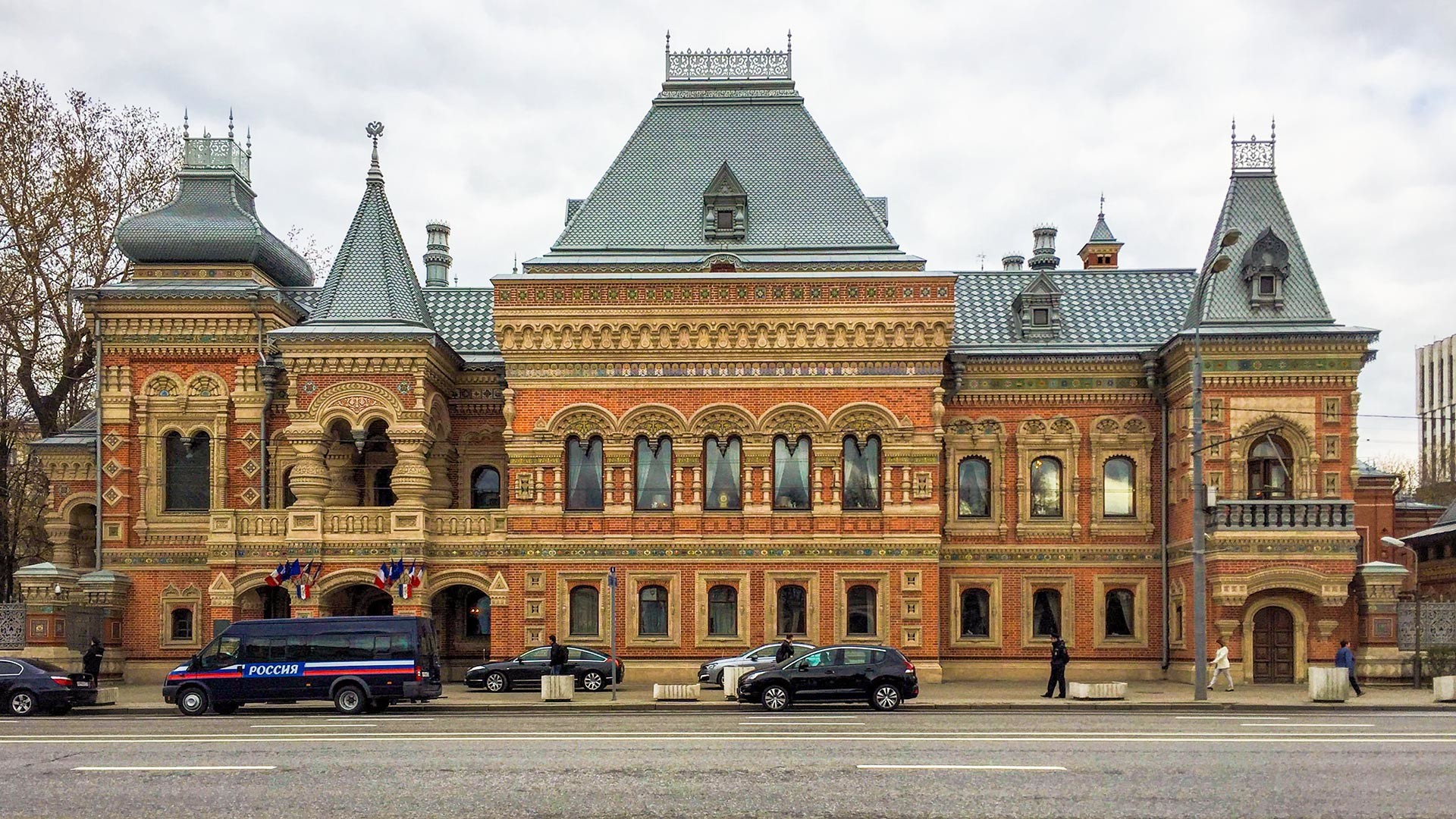
The owner of this mansion in Bolshaya Yakimanka street, Nikolai Igumnov, built it using old Russian chambers as an inspiration. Igumnov owned a gold mine and spent a million rubles on the building’s construction, which was an incredible amount at that time (the plot of land in the center of Moscow on which the house stands cost only about 17,000 rubles).

The building’s red bricks were ordered from the Netherlands, and each element of the façade—the windows, doors, balconies—has its own distinctive decor. The mosaic adorning the mansion depicts birds, flowers and plants from fairy tales. The building’s roof was made in different shapes.
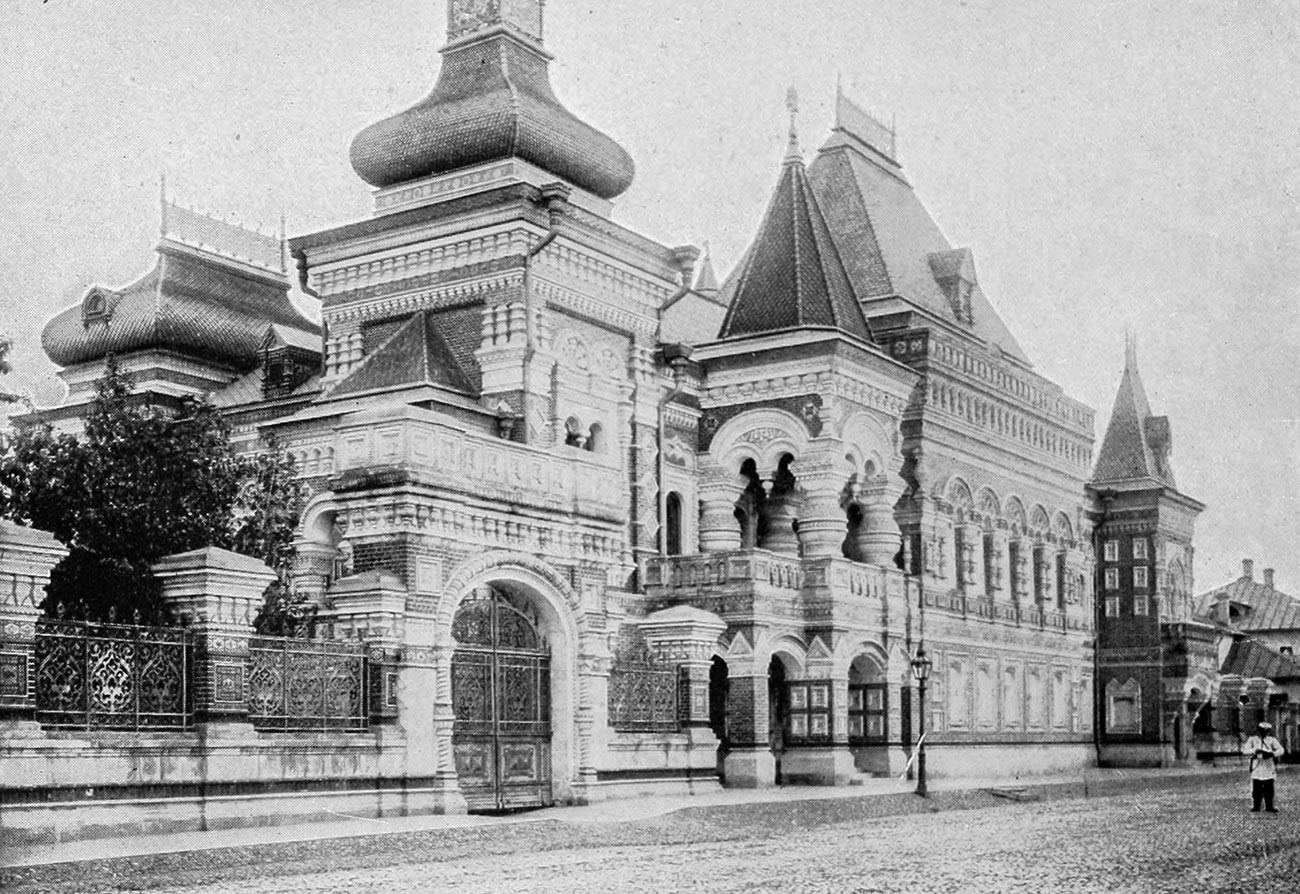
In 1901, Igumnov left for Abkhazia and never returned to Moscow. After the revolution, he voluntarily handed over the property to the Soviet government. Nowadays, the building houses the residence of the French ambassador.
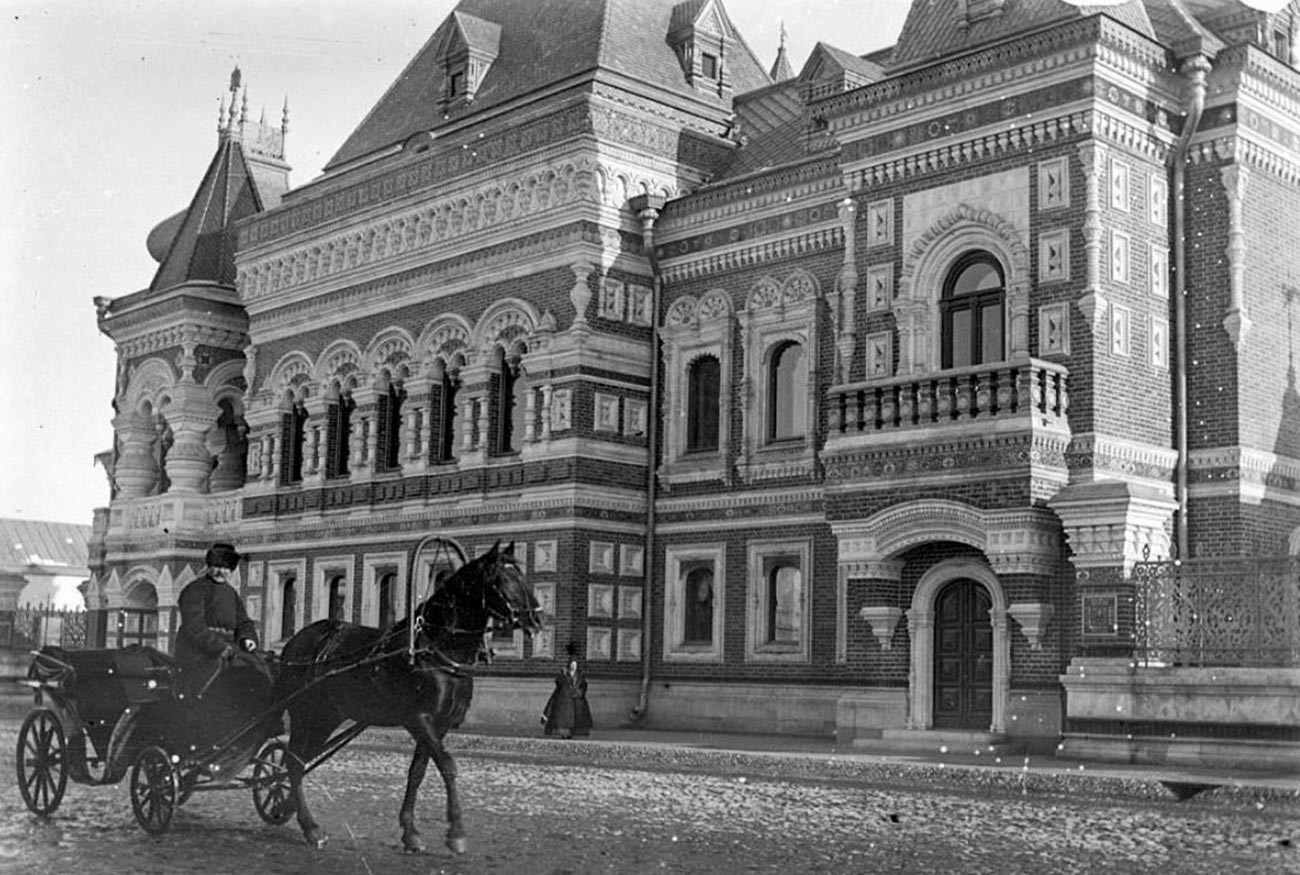
5. The Shchukin Mansion, 1893-1898
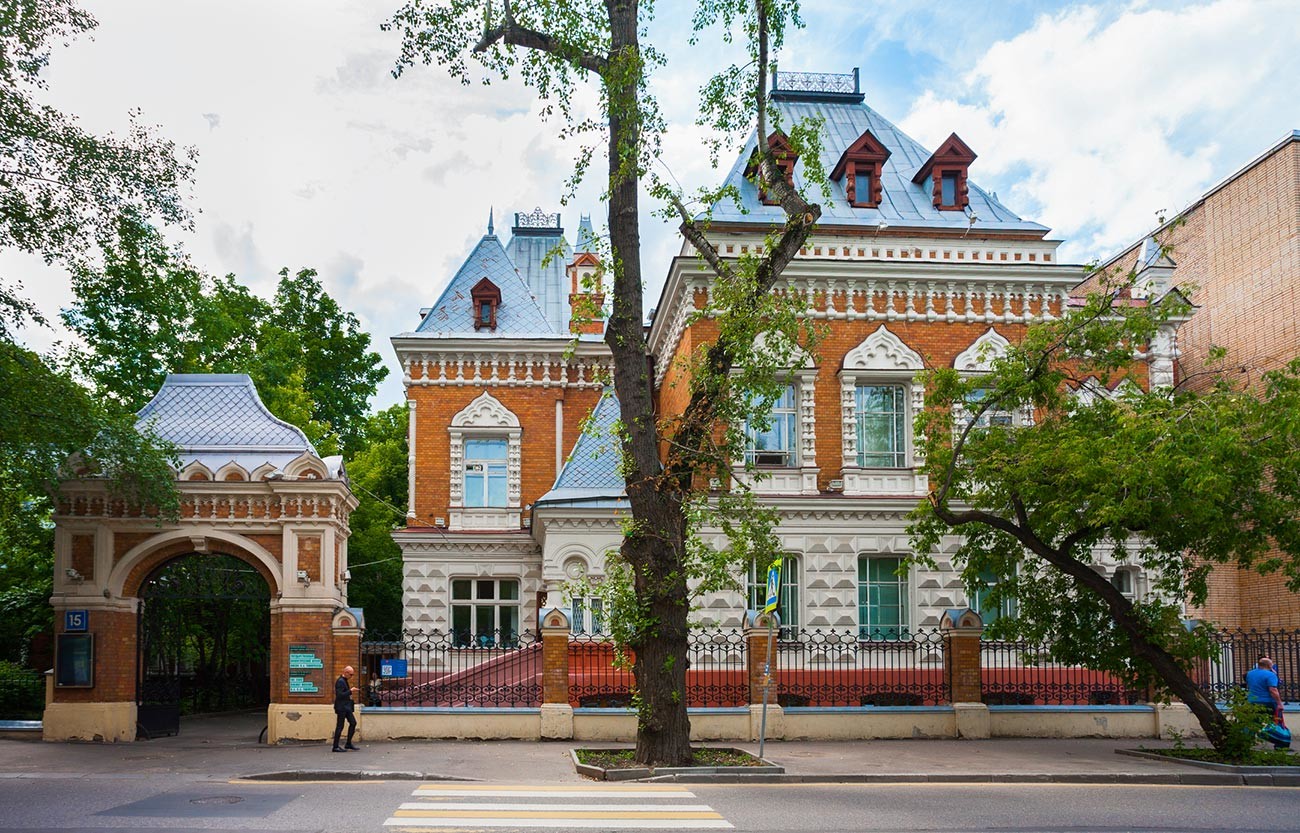
This huge house on Malaya Gruzinskaya street belonged to the merchant and philanthropist Pyotr Shchukin, who was an avid collector of Old Russian art. As his collection grew, he decided to build a separate building for it in the Russian style, which was fashionable at the time.
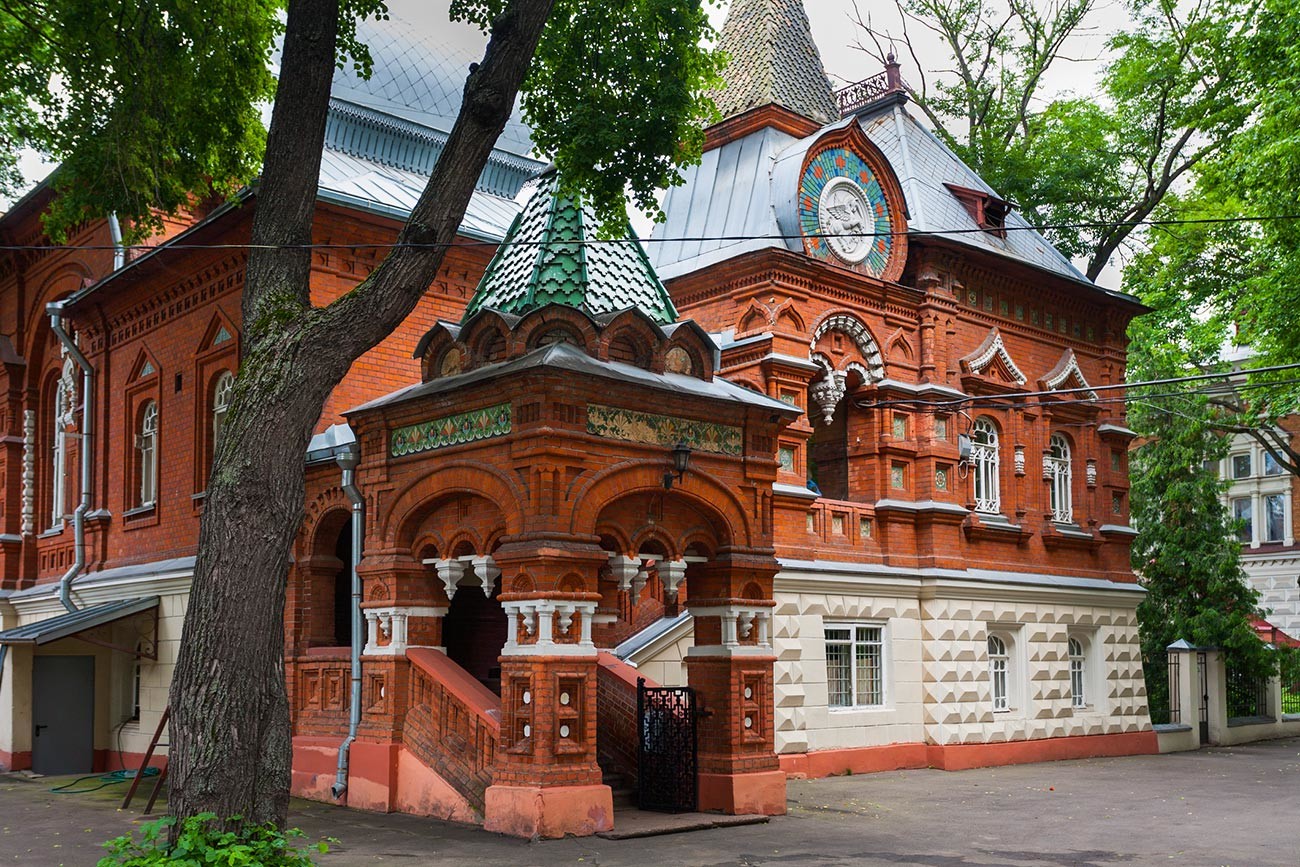
The main building had a wide porch decorated with a balcony (a smaller copy of the balcony of the Romanovs' chambers on Varvarka street) and multi-level pointed roofs. Inside, visitors found themselves in vaulted halls painted with floral designs. Several years later, another building was built next to the first one, also in the pseudo-Russian style but more spacious. Later, the two houses were connected by an underground passage.

In 1905, Shchukin donated his house to the Historical Museum but remained the curator of the collection until his death and even gave guided tours of the house himself. During the Soviet years, the building continued to be used as originally intended, exhibiting items from various museums. Today it houses the Timiryazev Biology Museum.
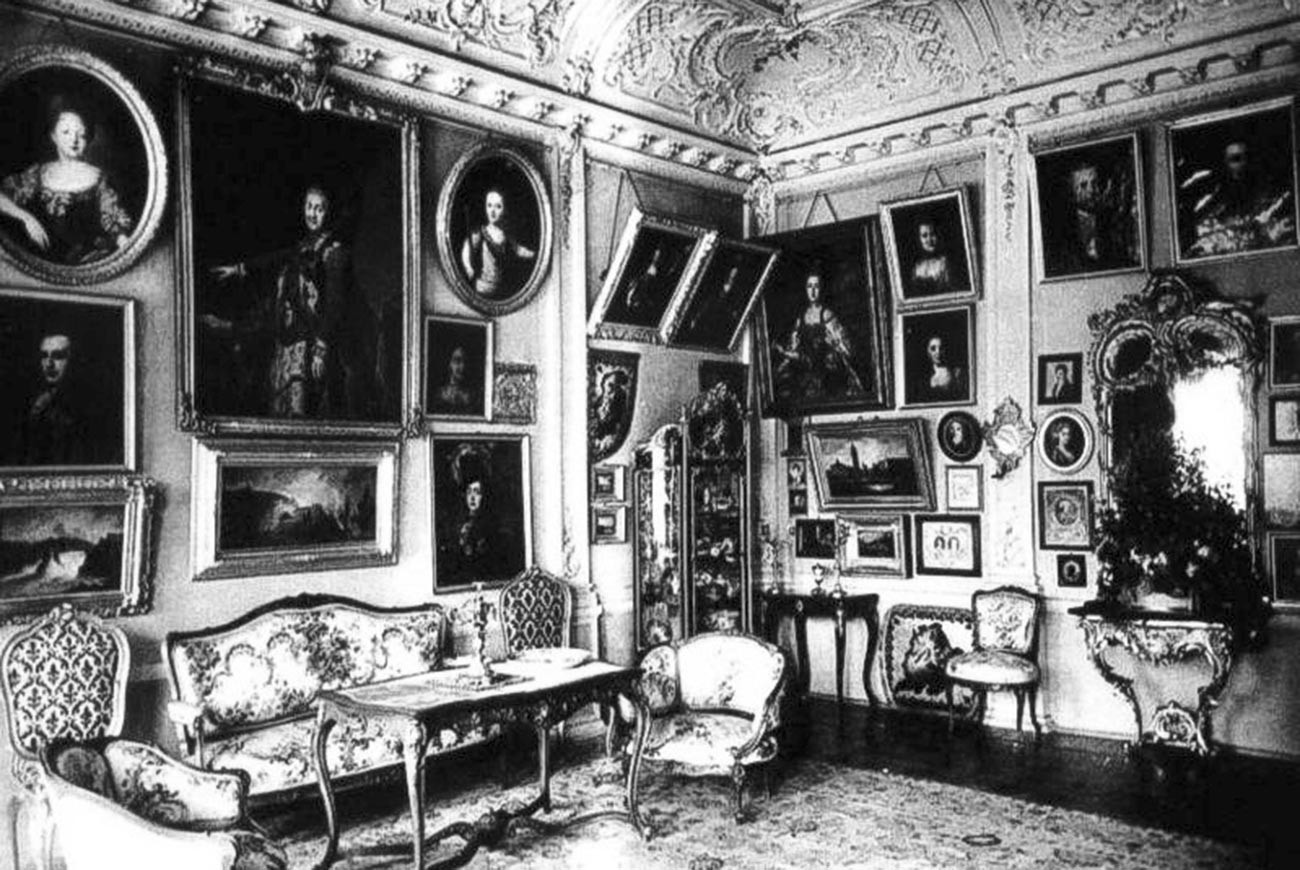
If using any of Russia Beyond's content, partly or in full, always provide an active hyperlink to the original material.
to our newsletter!
Get the week's best stories straight to your inbox
- Russia's most beautiful waterfronts (PHOTOS)
- Before and after: How Moscow has changed over the past 150 years
- 6 places in Russia where you will feel like you’re in another country (PHOTOS)
This website uses cookies. Click here to find out more.

The Doll’s House
Katherine mansfield, ask litcharts ai: the answer to your questions, kezia burnell, isabel burnell, else kelvey.

Lottie Burnell
Willie brent.

Home — Essay Samples — Geography & Travel — Travel and Tourism Industry — The History of Moscow City
The History of Moscow City
- Categories: Russia Travel and Tourism Industry
About this sample

Words: 614 |
Published: Feb 12, 2019
Words: 614 | Page: 1 | 4 min read

Cite this Essay
Let us write you an essay from scratch
- 450+ experts on 30 subjects ready to help
- Custom essay delivered in as few as 3 hours
Get high-quality help

Dr Jacklynne
Verified writer
- Expert in: Geography & Travel

+ 120 experts online
By clicking “Check Writers’ Offers”, you agree to our terms of service and privacy policy . We’ll occasionally send you promo and account related email
No need to pay just yet!
Related Essays
13 pages / 6011 words
1 pages / 657 words
4 pages / 2143 words
6 pages / 3010 words
Remember! This is just a sample.
You can get your custom paper by one of our expert writers.
121 writers online
Still can’t find what you need?
Browse our vast selection of original essay samples, each expertly formatted and styled
Related Essays on Travel and Tourism Industry
The ethics in the hospitality industry play a pivotal role in shaping the reputation and success of businesses within this sector. Ethics encompass the principles and values that guide behavior, decision-making, and interactions [...]
Traveling is an enriching experience that allows individuals to explore new cultures, meet people from different backgrounds, and broaden their perspectives. In the summer of 2019, I had the opportunity to embark on an amazing [...]
Travelling is a topic that has been debated for centuries, with some arguing that it is a waste of time and money, while others believe that it is an essential part of life. In this essay, I will argue that travelling is not [...]
Traveling has always been a significant part of my life. From a young age, I have been fortunate enough to explore different cultures, experience new traditions, and immerse myself in the beauty of our world. My passion for [...]
When planning a business trip all aspects and decisions rely heavily on the budget set by the company for the trip. Once Sandfords have confirmed the location careful consideration should be used to choose the travel method and [...]
Tourism is an action of worldwide imperativeness and importance as it is a major force in the economy (Cooper et al. 2008). Tourism has undeniably developed as one of the most significant economic and social phenomena of the [...]
Related Topics
By clicking “Send”, you agree to our Terms of service and Privacy statement . We will occasionally send you account related emails.
Where do you want us to send this sample?
By clicking “Continue”, you agree to our terms of service and privacy policy.
Be careful. This essay is not unique
This essay was donated by a student and is likely to have been used and submitted before
Download this Sample
Free samples may contain mistakes and not unique parts
Sorry, we could not paraphrase this essay. Our professional writers can rewrite it and get you a unique paper.
Please check your inbox.
We can write you a custom essay that will follow your exact instructions and meet the deadlines. Let's fix your grades together!
Get Your Personalized Essay in 3 Hours or Less!
We use cookies to personalyze your web-site experience. By continuing we’ll assume you board with our cookie policy .
- Instructions Followed To The Letter
- Deadlines Met At Every Stage
- Unique And Plagiarism Free

IMAGES
VIDEO
COMMENTS
THE DOLL'S HOUSE (1922) By Katherine Mansfield When dear old Mrs. Hay went back to town after staying with the Burnells she sent the children a doll's house. It was so big that the carter and Pat carried it into the courtyard, and there it stayed, propped up on two wooden boxes beside the feed-room door. No harm could come to it; it was summer.
Published in The Dove's Nest, Katherine Mansfield's last collection of short stories, "The Doll's House" belongs with "Prelude" (1920) and "At the Bay" (1922) among the Burnell stories, a trilogy based on the re-creation of a New Zealand childhood that threads family life with social satire while exploring issues of identity and belonging.
The fact that the doll's house has been sent from town emphasizes that the Burnells live out in the country. The Burnells might be the wealthiest family in their village, but they are not living among more fashionable society. That the house is left it in the courtyard next to the feed-room—hardly a place of honor—suggests it is not ...
The Doll's House Summary. A doll's house arrives at the Burnell home as a gift. The dollhouse smells so strongly of paint that Aunt Beryl thinks it could make someone sick. Isabel, Lottie, and Kezia, the Burnell's three daughters, do not mind the smell, however, and couldn't be more delighted by the house. Kezia, the youngest sister ...
Last Updated September 5, 2023. "The Doll's House" by Katherine Mansfield is an extended metaphor for social class discrimination and warfare. The story centers on three wealthy sisters and ...
Last Updated September 5, 2023. Katherine Mansfield's short story "The Doll's House" commences when Mrs. Hay, a previous guest of the wealthy Burnell family, sends the Burnell daughters a ...
Katherine Mansfield was born Kathleen Beauchamp in New Zealand to a prominent English family in New Zealand. Much of her childhood was spent in the small, country village of Karori, where she was educated in a village school alongside the children of housekeepers, milkmen, and other lower-class children, just like the Burnell sisters in "The Doll's House."
The Doll's House. In "The Doll's House," Mansfield depicts the cruelty of class discrimination inflicted upon two little girls and examines how children learn their behavior from the adults in their lives and soon know their place in the social order. "The Doll's House," like many other short stories by Katherine Mansfield, reflects ...
"The Doll's House" examines the intricacies of girlhood within the insular setting of a rural New Zealand village. By using free indirect discourse that allows the reader to access several different characters' consciousnesses, Mansfield establishes a somewhat objective scene. Girlhood is a tricky maze to navigate, especially for girls who find themselves lacking the benefits of ...
The Doll's House" is a 1922 short story by Katherine Mansfield. It was first published in The Nation and Atheneum on 4 February 1922 and subsequently appeared in The Doves' Nest and Other Stories (1923). Mansfield used an alternative title in other editions, including "At Karori".
Analysis of The Doll's House by Katherine Mansfield. The Doll's House by Katherine Mansfield, published in 1922, is a short story written in third-person, through an omniscient narrator. It discusses societal class and ostracization through the lens of two sets of school-going sisters from different family backgrounds.
Mansfield's story ''The Doll's House'' is a work that relies on the careful balance of its elements in order to make its unstated points felt. ... Critical Essay on ''The Doll's House,'' in Short Stories for Students, Gale, Cengage Learning, 2010. Related Posts: The Doll's House by Katherine Mansfield - Literary Devices ...
Summary of The Doll's House. The Doll's House is a short story written by Katherine Mansfield in 1922. It delves into themes of social class, prejudice, and the innocence of children. Set in late 1800s New Zealand, a British colony, the story follows the Burnell family, consisting of three girls, who receive a doll's house as a gift.
for only $0.70/week. Subscribe. By Katherine Mansfield. Thanks for exploring this SuperSummary Study Guide of "The Doll's House" by Katherine Mansfield. A modern alternative to SparkNotes and CliffsNotes, SuperSummary offers high-quality Study Guides with detailed chapter summaries and analysis of major themes, characters, and more.
The Doll's House study guide contains a biography of Katherine Mansfield, literature essays, quiz questions, major themes, characters, and a full summary and analysis. Best summary PDF, themes, and quotes.
Katherine Mansfield's "The Dolls House" seems to be a simple story about children receiving a own ideas and opinions. Even though everyone is entitled to their own opinion it is often bizarre to see how our opinions are based on those of others. This essay will outline the events that occurred in the story which are a big part in regards to the ...
Based on Mansfield's own childhood experiences of moving from the New Zealand town of Wellington to the rural village of Karori, The Doll's House is a critique of small-town vanity. Beyond emphasizing the arbitrary nature of class division, the story also mocks the narrow-minded provincialism of the Burnells—the most distinguished family in a tiny village, outside a small town, on a far ...
The Doll's House by Katherine Mansfield. The Doll's House. WHEN dear old Mrs. Hay went back to town after staying with the Burnells she sent the children a doll's house. It was so big that the carter and Pat carried it into the courtyard, and there it stayed, propped up on two wooden boxes beside the feed-room door.
The exhibition's curator Jean-Louis Cohen explains that Le Corbusier saw Moscow as "somewhere he could experiment.". Indeed, when the architect was commissioned to construct the famous ...
McConnell House. 1886-1901, William J. McConnell. 110 S. Adams St. In 1886, entrepreneur William E. McConnell began building a two-story house, sunken garden, small carriage house, and barn for his family on an entire block in the Fort Russell neighborhood. Like other early Fort Russell residents, McConnell sited the house on the block's ...
3. The Pertsova House, 1905-1907. A.Savin (CC BY-SA 3.0) This fairy tale house on Prechistenskaya Embankment is one of the most striking buildings in Moscow. It was commissioned by a railroad ...
Pat. Pat is the Burnell family handyman. He brings the doll's house into the courtyard and picks up the Burnell girls from school. Mrs. Burnell. Mother of Isabel, Lottie, and Kezia. When Kezia asks her if she can invite Lil and Else Kelvey to see the doll's house, she tells her no, and does not explain why except to say, "Run away, Kezia ...
The History of Moscow City. Moscow is the capital and largest city of Russia as well as the. It is also the 4th largest city in the world, and is the first in size among all European cities. Moscow was founded in 1147 by Yuri Dolgoruki, a prince of the region. The town lay on important land and water trade routes, and it grew and prospered.